Travel Europe
On Friday, June 9th, we moved from our very basic hotel in Varenna to the delightful Royal Victoria Hotel to begin the tour. It kicked off with a get together in the late afternoon. The guide led an orientation walk, which we skipped since we already knew the town. We had dinner and went back to our room.
Saturday was a day “on our own” with the tour providing ferry tickets. We returned to Bellagio and did a little shopping. Then back to Varenna for a light lunch and a visit to the Villa Monastero botanical gardens.
In the late afternoon, we met some of the tour group for drinks at a local bar.
ann Arato
16 chapters
19 Mar 2023
Italy - Rick Steves Best of Italy tour
Italy
On Friday, June 9th, we moved from our very basic hotel in Varenna to the delightful Royal Victoria Hotel to begin the tour. It kicked off with a get together in the late afternoon. The guide led an orientation walk, which we skipped since we already knew the town. We had dinner and went back to our room.
Saturday was a day “on our own” with the tour providing ferry tickets. We returned to Bellagio and did a little shopping. Then back to Varenna for a light lunch and a visit to the Villa Monastero botanical gardens.
In the late afternoon, we met some of the tour group for drinks at a local bar.
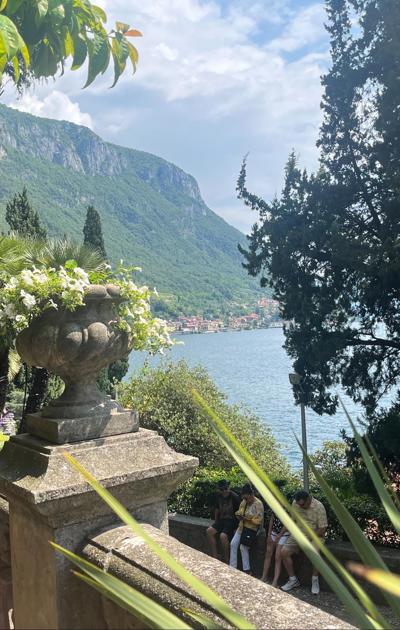
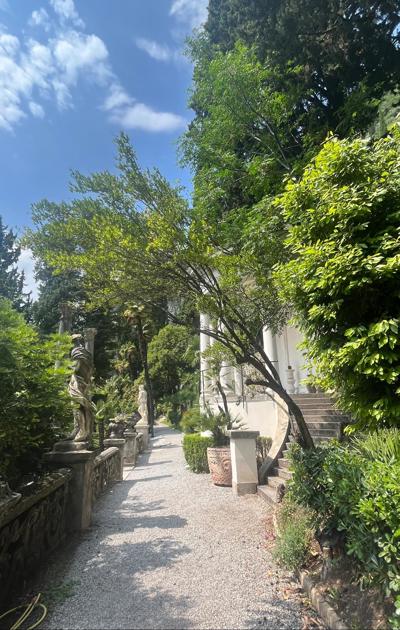

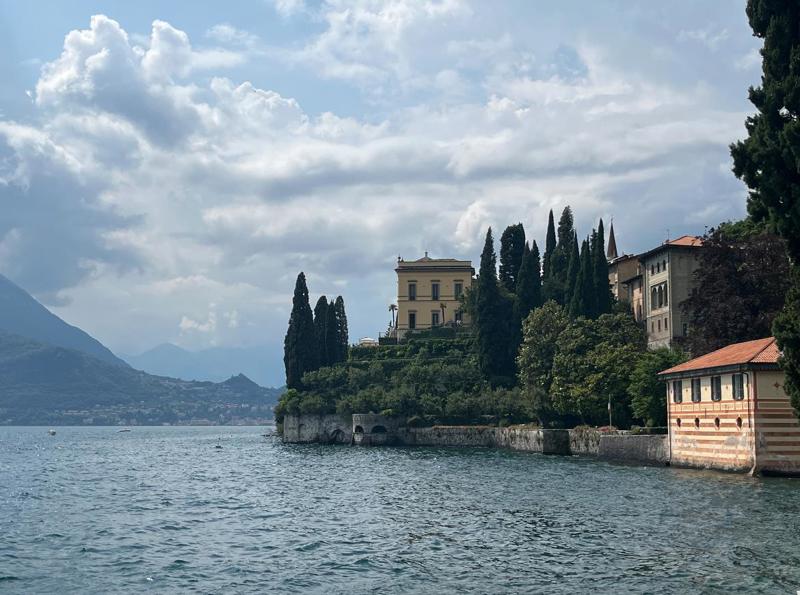
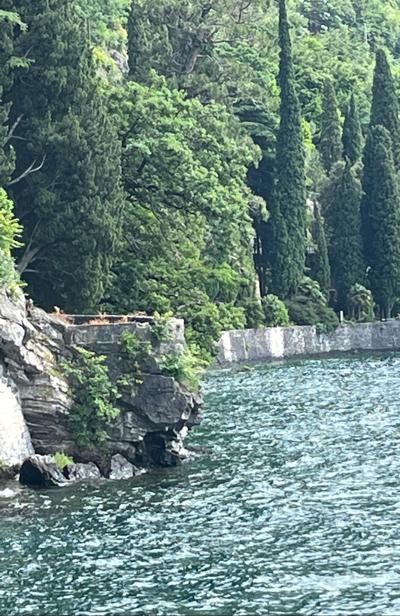
After a casual dinner, we headed back to the hotel to pack our bags.
There are twenty-eight people on the tour. Mostly couples around our age and all from the US. They’re an interesting group. The guide is superb - knowledgeable, funny, interesting and firm in her directions.
On Sunday we boarded the bus to begin our drive north. We drove through many towns and villages and through the Lombardia region and the Brenner pass. Our first stop was a small town called Egna for a light lunch; it was a quaint town of about 15,000.
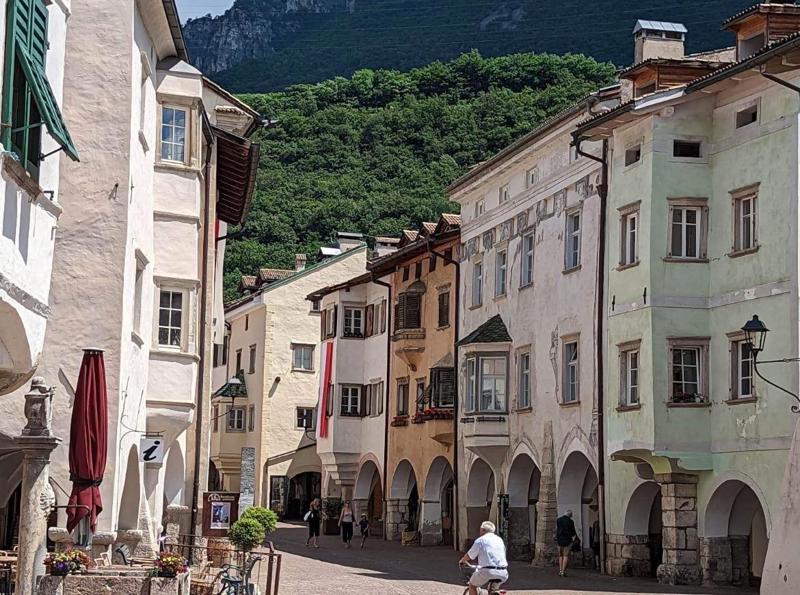
After lunch we drove to Bolzano in South Tyrol with great views of the Dolomites along the way. After arrival at another lovely hotel, we walked to the South Tyrol Museum of Archaeology where it is all about Otzi.
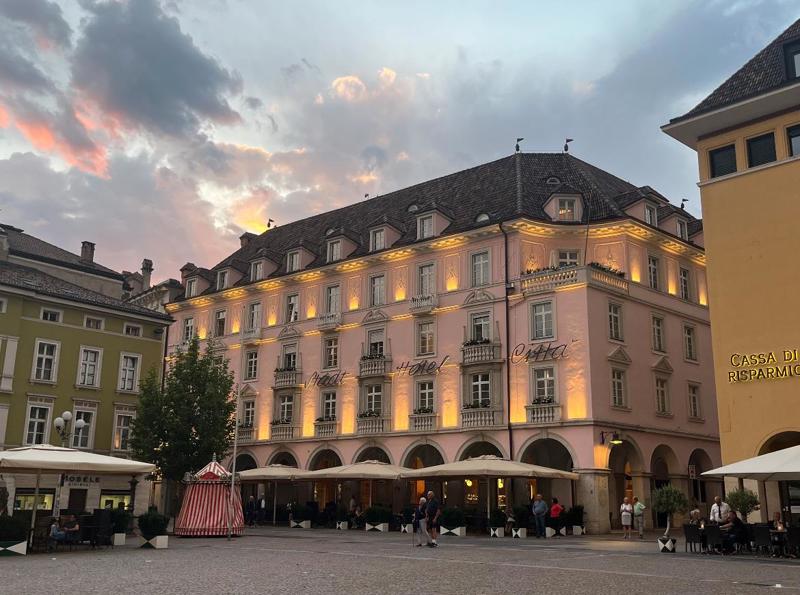
Ötzi, also called the Iceman, is the natural mummy of a man who lived between 3350 and 3105 BC. Ötzi was discovered in September 1991 in the Ötztal Alps at the border between Austria and Italy. He is Europe's oldest known natural human mummy. The museum does a wonderful job of explaining what has been learned about his life and death. It’s hard to wrap one’s mind around the timeframe in which he lived. No photos of the mummy were allowed but they showed this figure of how he may have looked.
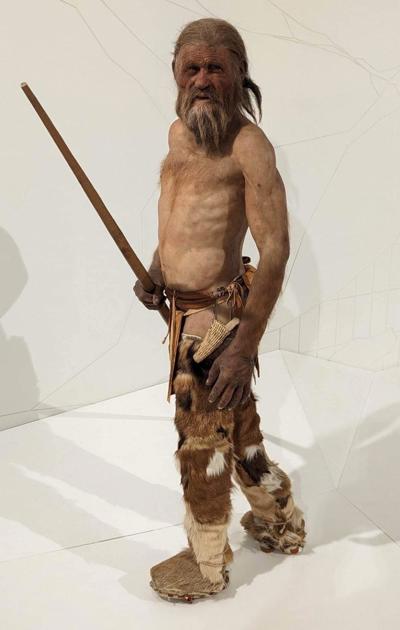
After the museum the group got together for a traditional German meal in a restaurant housed in an 800 year old building. South Tyrol, once part of the Austro-Hungarian Empire, was annexed to Italy in 1919, at the end of the World War I. The area feels more German than Italian to this day.
We walked around the town square after dinner before returning to our hotel.

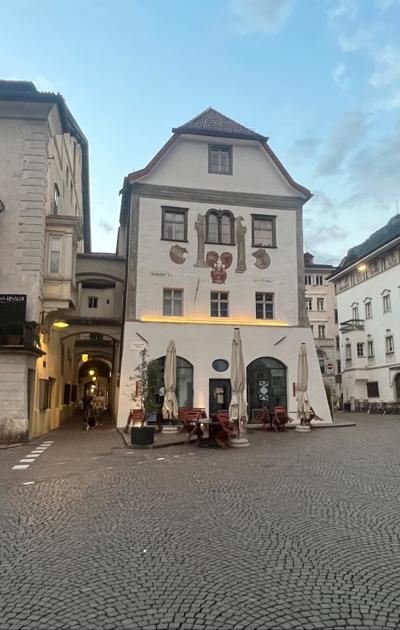
On Monday, June 12th, we got up early and did a three hour hike in the Dolomites. We hiked a trail around the Alpe di Suisi - the highest alpine meadow in Europe. It was stunning! The views of the mountains and the meadows were so expansive. Pictures simply can’t do it justice. Walking back down a path beside a meadow, I had a definite “The Hills Are Alive” moment. I refrained, though, from breaking into song!
The Witches’ Benches on the trail are considered a magical spot. It is here that the Schlern witches are said to have gathered together before flying over the Schlern.
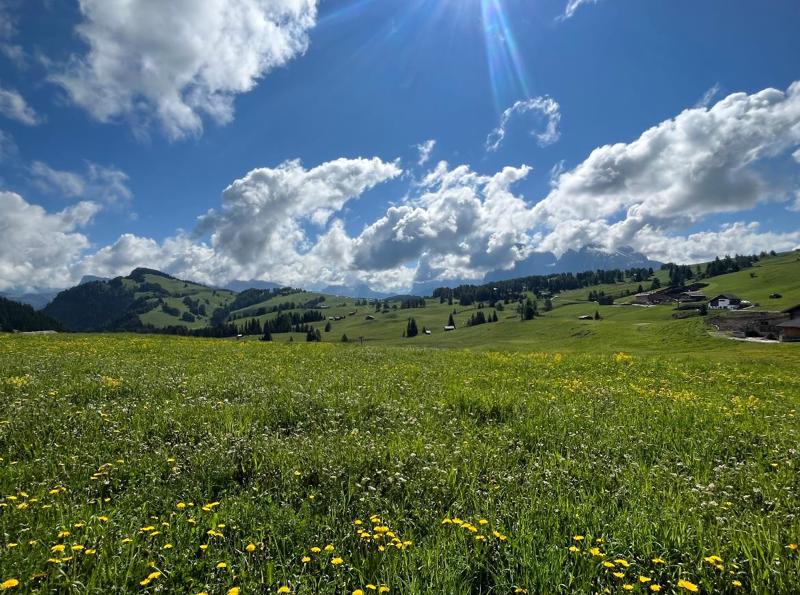
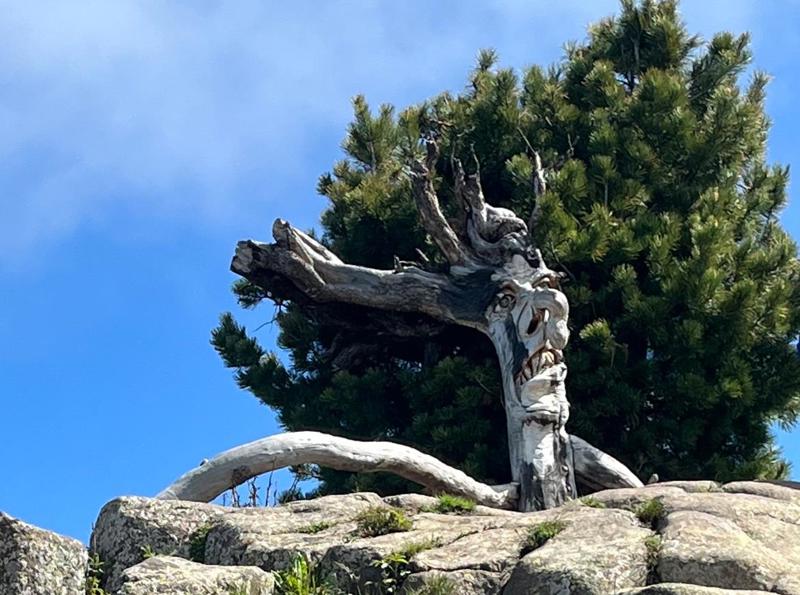
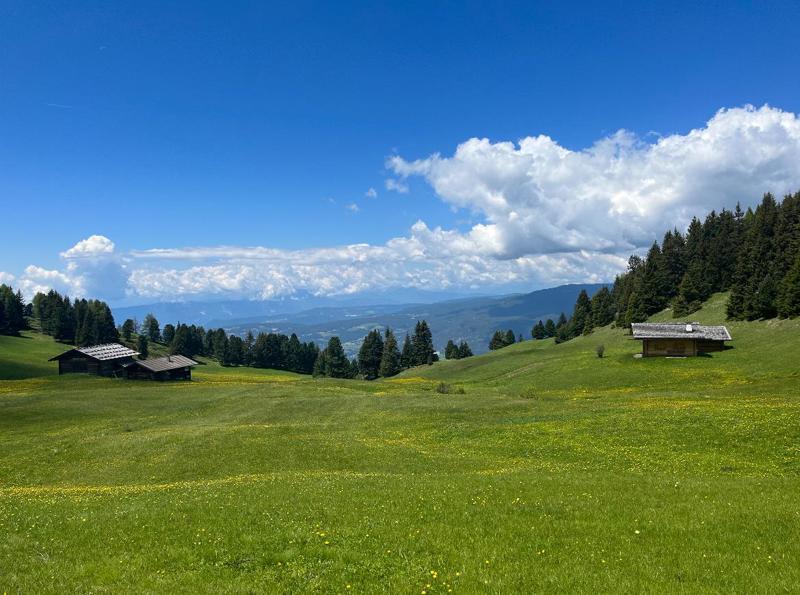
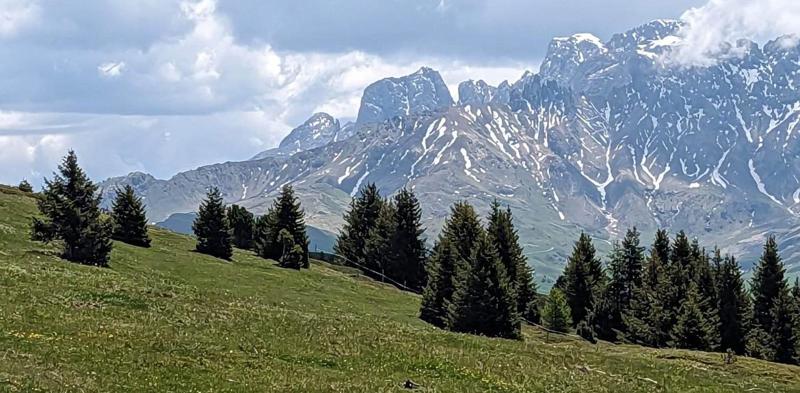
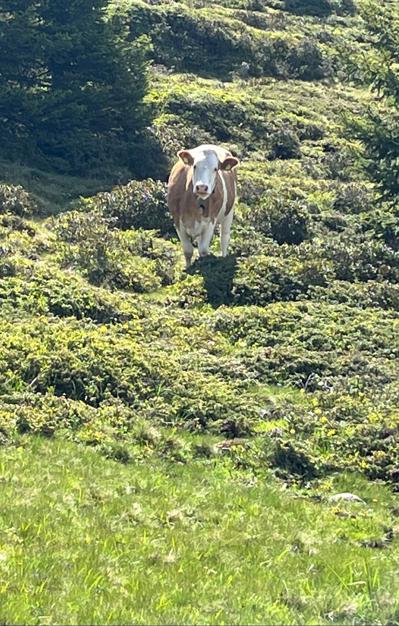
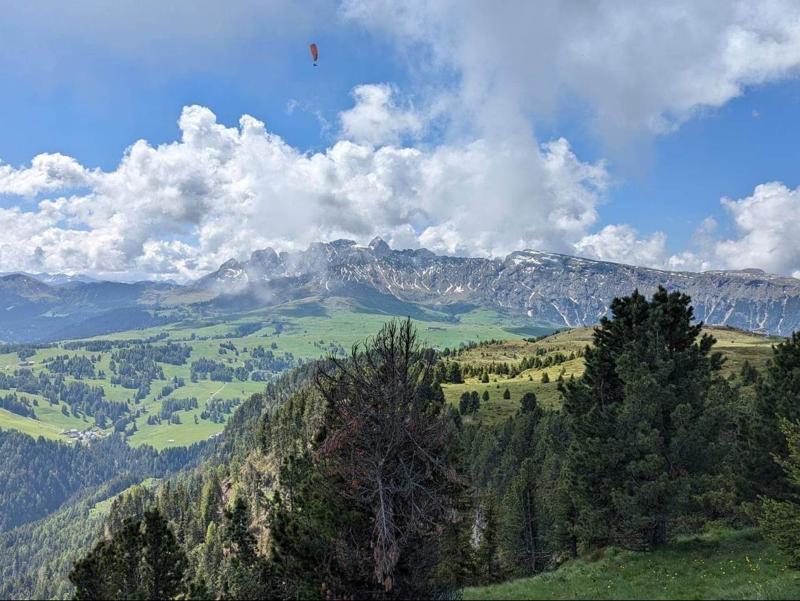
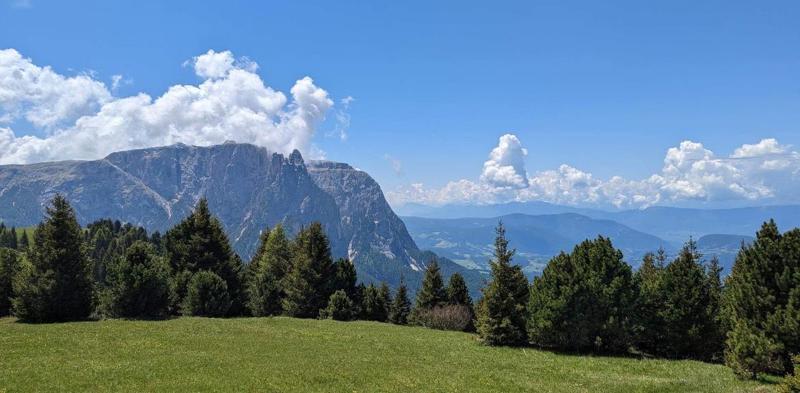
Driving back to our hotel, we could have been in Bavaria based on the style of houses we saw. After a rest, we had dinner and then a short walk around the town.
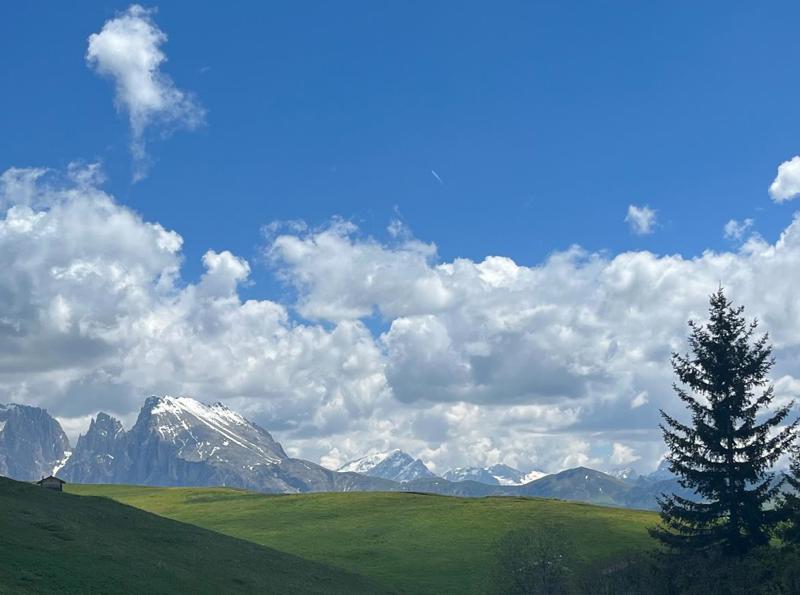
On Tuesday, we drove back south through the Brenner Pass to Verona.
In Verona, a local tour guide named Valeria joined our group. She led us throughout parts of the city and provided a wealth of information on the architecture and history. It was the best city tour we had ever experienced.
The historic city of Verona was established in the 1st century B.C. by Julius Caesar. It particularly flourished under the rule of the Scaliger family in the 13th and 14th centuries. Verona has preserved a remarkable number of monuments from antiquity, the medieval and Renaissance periods, and represents an outstanding example of a military stronghold.
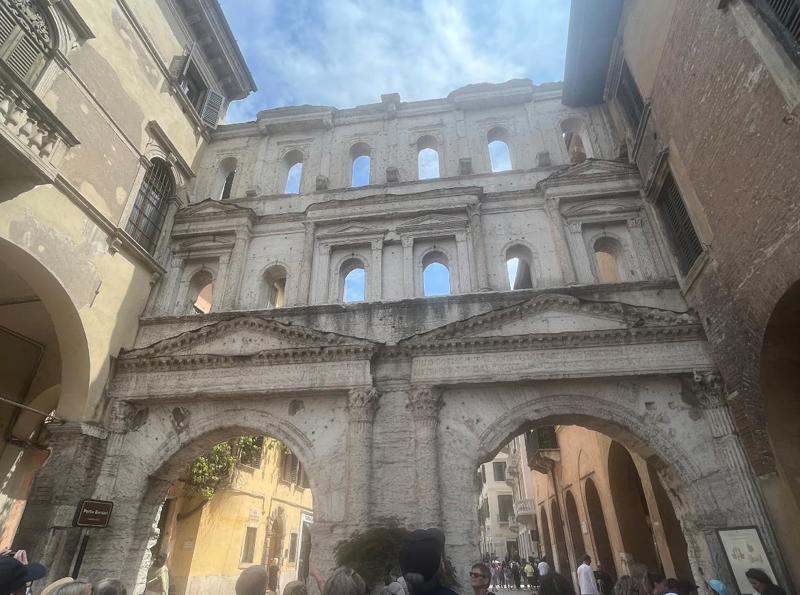
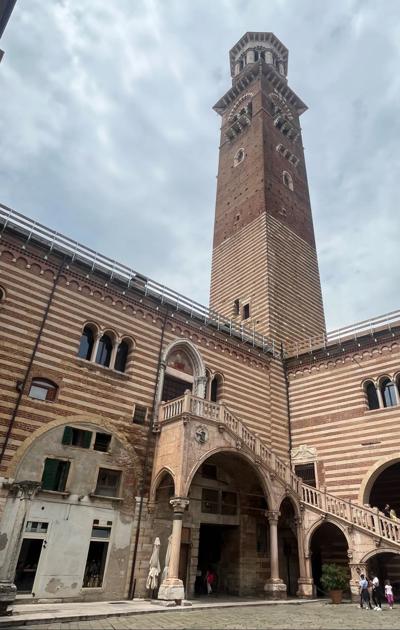
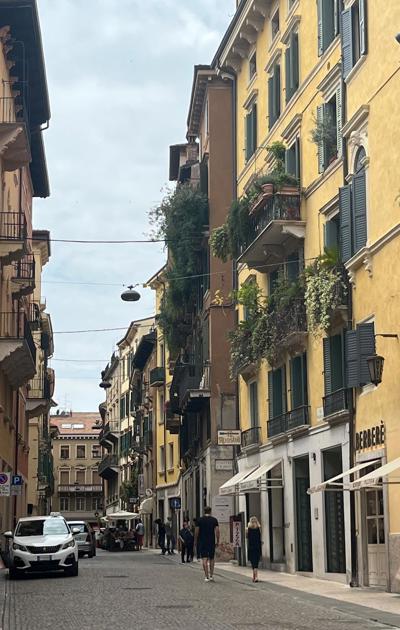
We also visited the Casa di Giulietta - a renovated 13th-century residence that once belonged to a noble family, the del Cappellos, who are believed by locals to have inspired the fictional family of Juliet Capulet in Shakespeare's play. The balcony was added to the building in the 20th century. We made a quick visit to see the balcony amongst throngs of tourists.
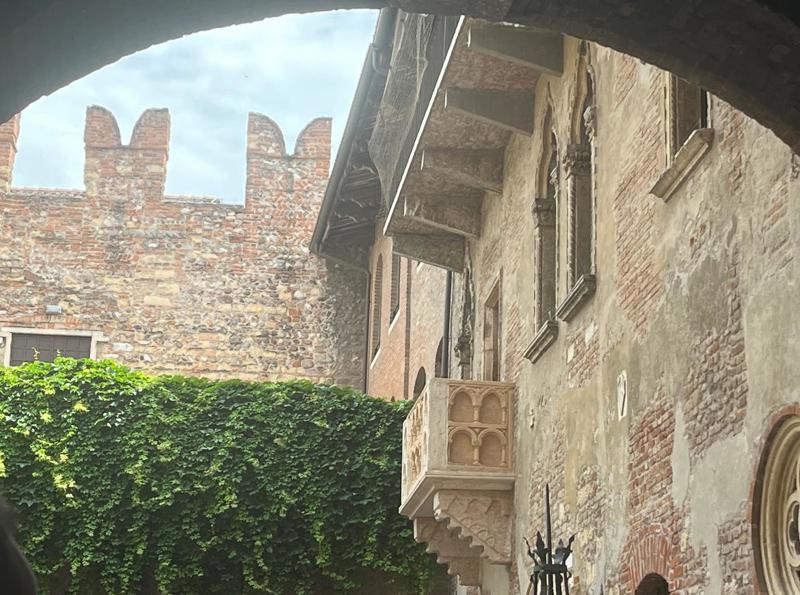
The tour took us to Verona’s arena. The Arena is the Roman amphitheater. It was built in the first century AD to watch the fights of gladiators. It is one of the best preserved ancient structures of its kind. In ancient times, the arena's capacity was nearly 30,000 people. Our tour guide led the group through a reenactment of a gladiator fight which was hilarious.
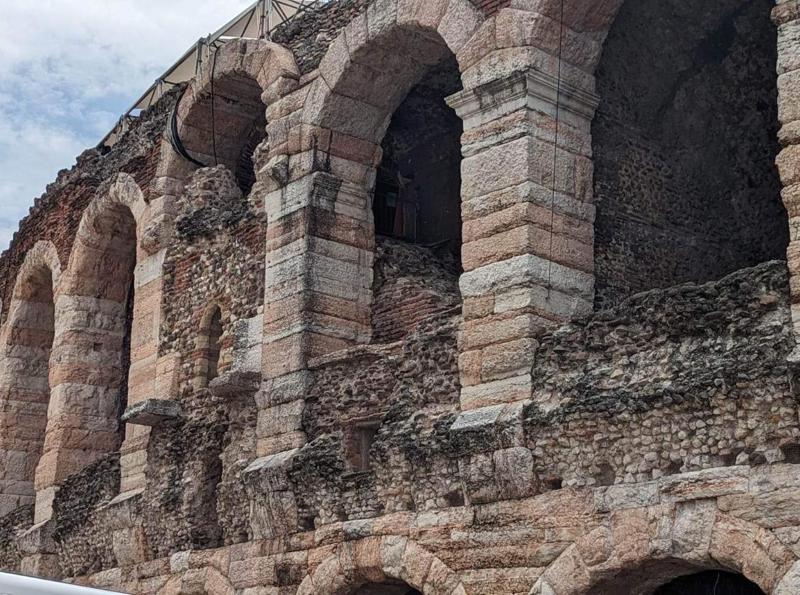
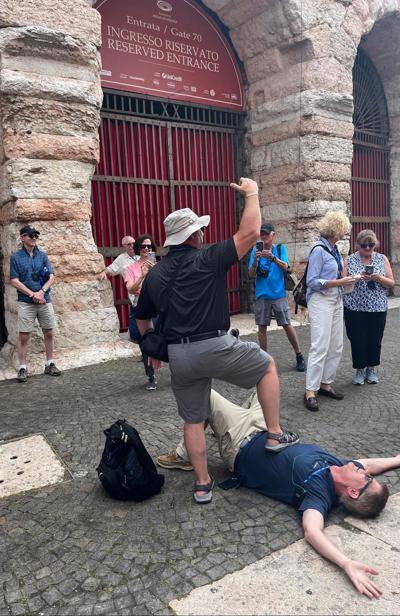
The last building was saw was Castelvecchio (Italian: "Old Castle"). It is the most important military construction of the Scaliger dynasty.
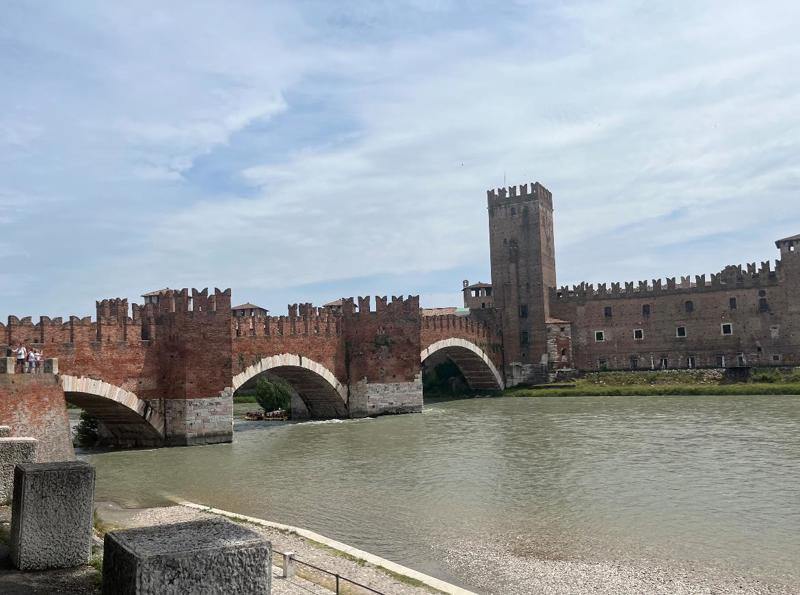
Arriving in Venice, we took a water taxi to our hotel. Venice seems surreal. It feels like a different world. After a brief orientation walk, we went out for dinner as a group and then took an evening gondola ride.
The gondola ride was wonderful … and mildly terrifying. Those things really lean! It was interesting to see the homes and businesses from the level of the canals. The ride up the Grand Canal was awe inspiring.

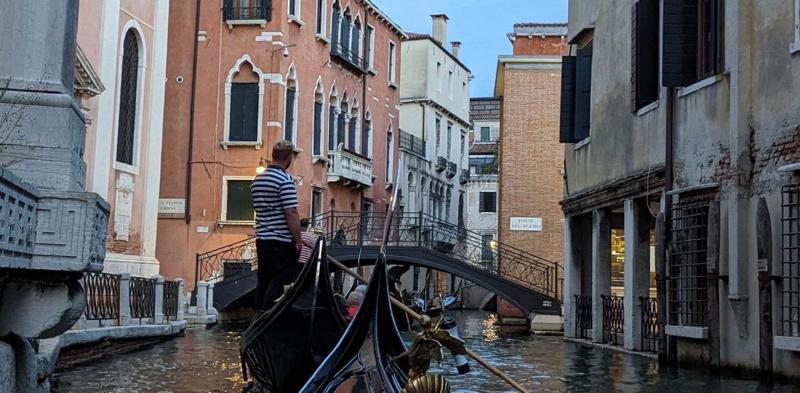
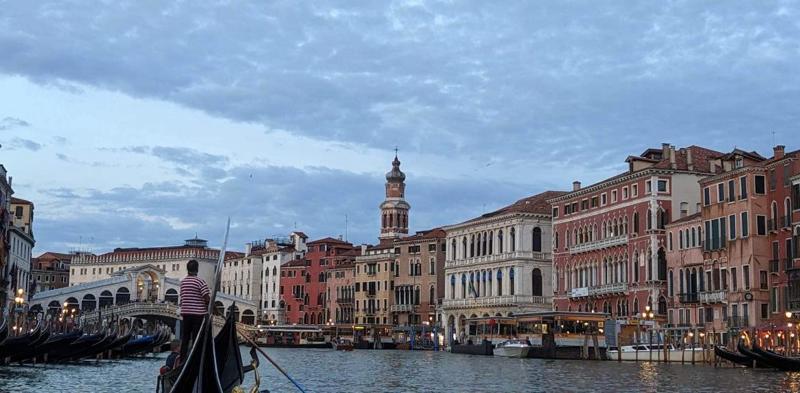
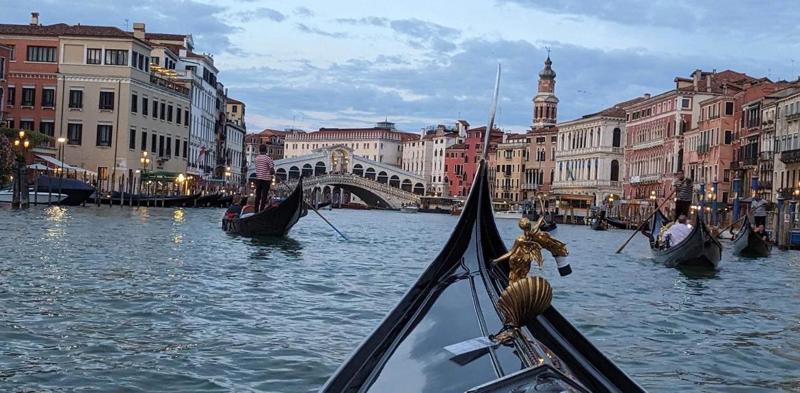
We had our first view of the incredible Piazza San Marco (or St. Mark’s Square) - the city's main public square containing its most famous buildings such as St Mark's Basilica and the Doge's Palace. Napoleon called it “the world's most beautiful drawing room”.
We saw firsthand the problems currently being experienced in Venice as the square was flooded by underground water bubbling up.
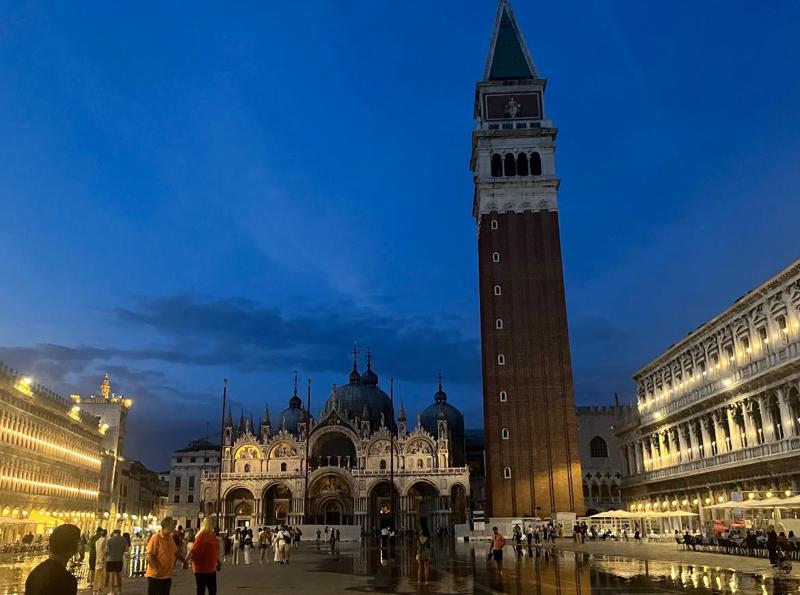
The next morning we had a guided walk of Venice with another local tour guide. She covered the city’s history and architecture and spoke about the challenges facing modern day Venice. We learned that Venice is situated across a group of 118 small islands that are separated by canals and linked by bridges, of which there are 400. There is no green space on the island. It truly feels like a different world.
Strolling through Venice is akin to walking through a living museum.
I find it fascinating how the land and water interact in this city, with both serving as “streets”.
We also visited with a craftsman who makes the forcola - the rowlock or oarpost used in traditional Venetian boats. The craftsmanship was beautiful.
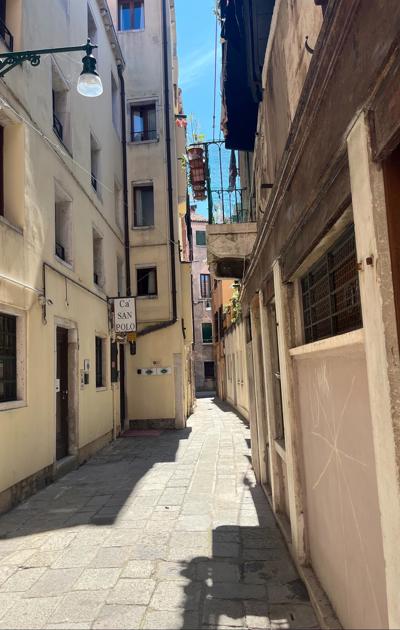
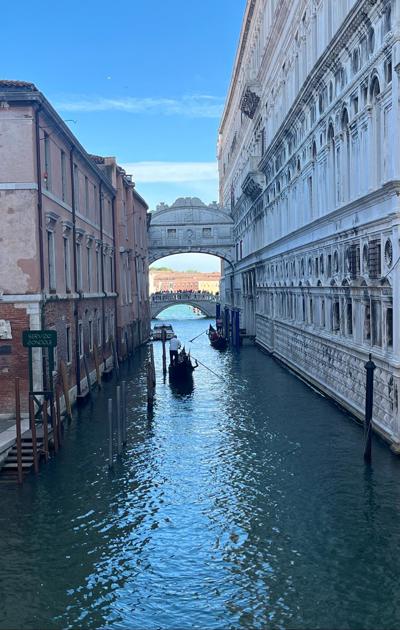
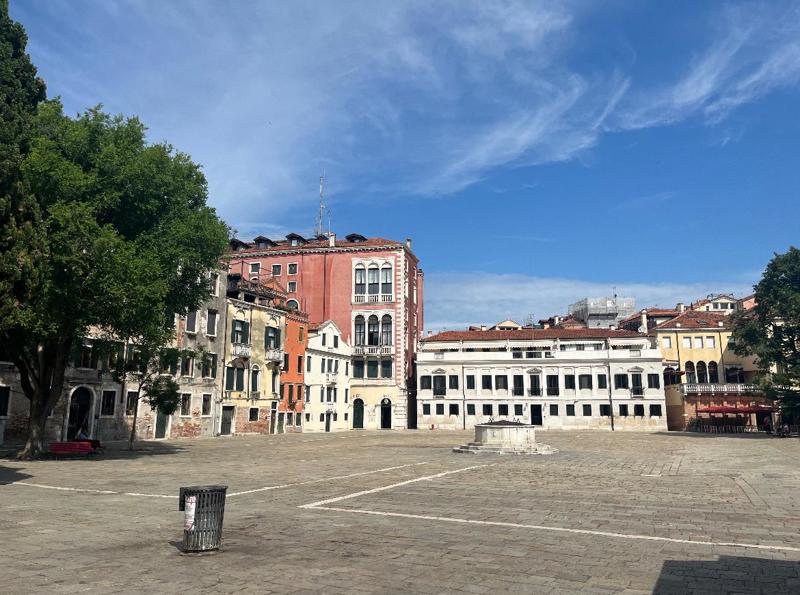
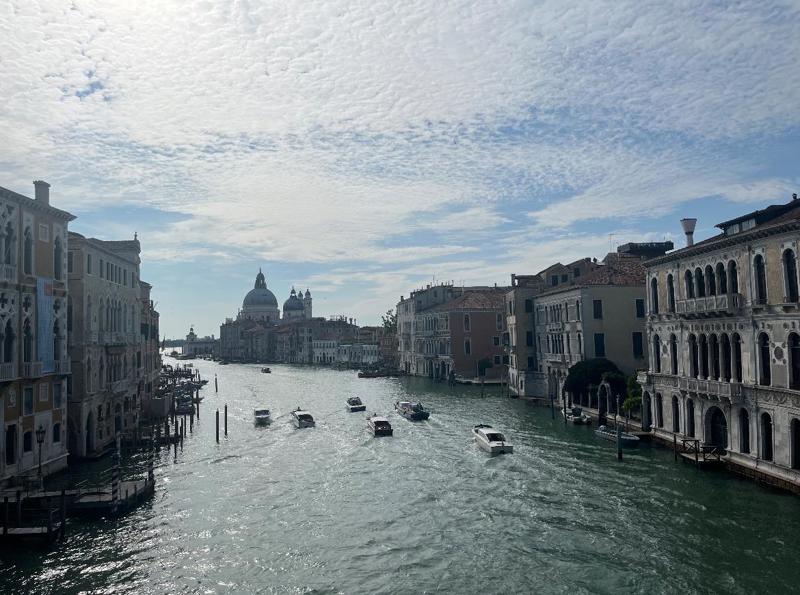
After the tour, we visited St. Mark’s basilica - an iconic symbol of Venice. Initially designed to function as a private chapel for the Doge, the church over centuries, took up a significant role in the religious and political life of the city. The Basilica was built to guard Saint Mark 'the evangelist’s' relics, which were stolen in Alexandria, Egypt. Also known as ‘the Golden Church’, St. Mark’s Basilica is famous for the dominance of golden mosaics, quite a sight to witness in the world of art.
I always feel a certain ethical conflict visiting these beautiful European churches. The art and architecture are generally breathtaking. Yet, the level of excess is hard to justify. That being said, St. Mark’s is beautiful (albeit dark). Amidst everything, I think I was most taken with the floor mosaics.
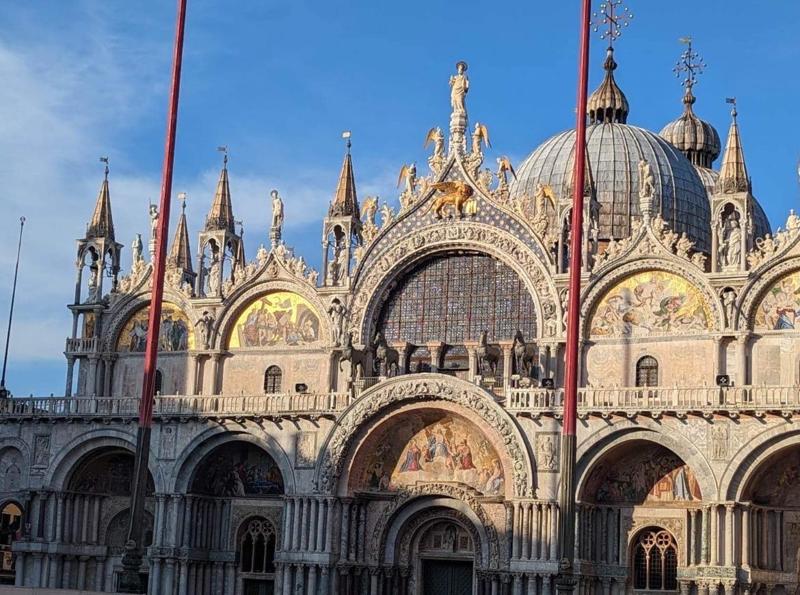
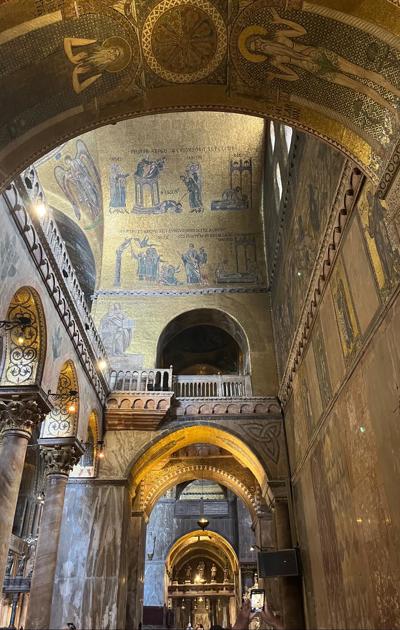
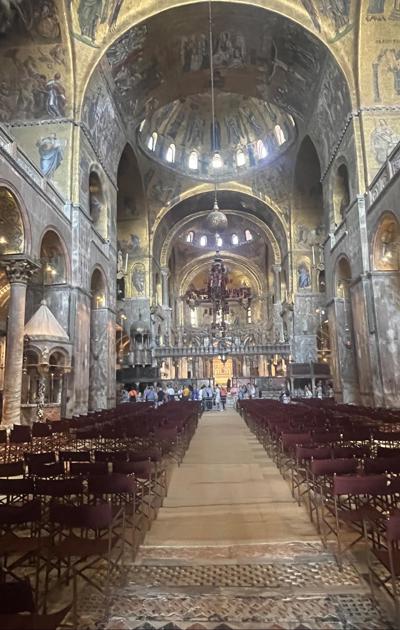
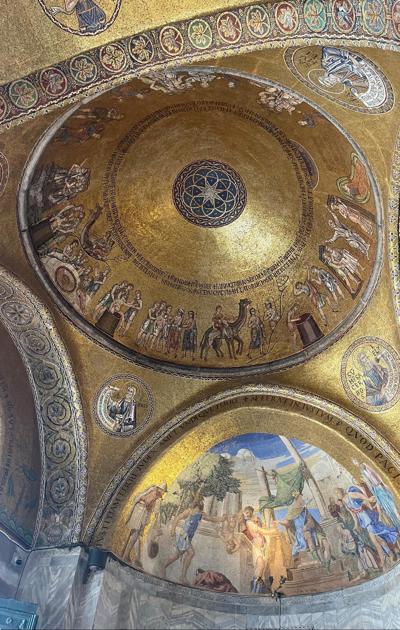
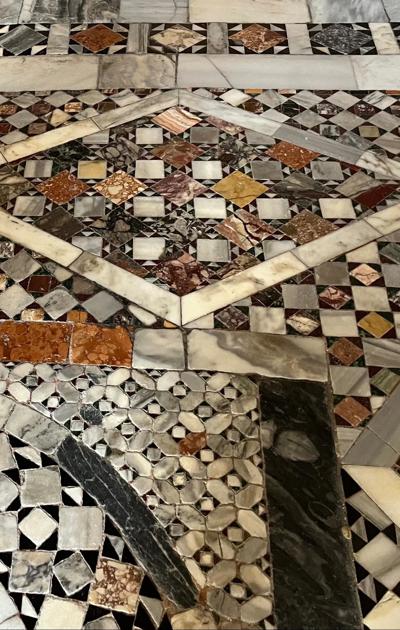
After the basilica, we spent the day wandering the city. We shopped for Murano glass at the infamous Rialto Bridge, got lost a few times, and stopped for dinner at an outdoor cafe. We ended the evening with a last walk around the square. Venice did not disappoint!
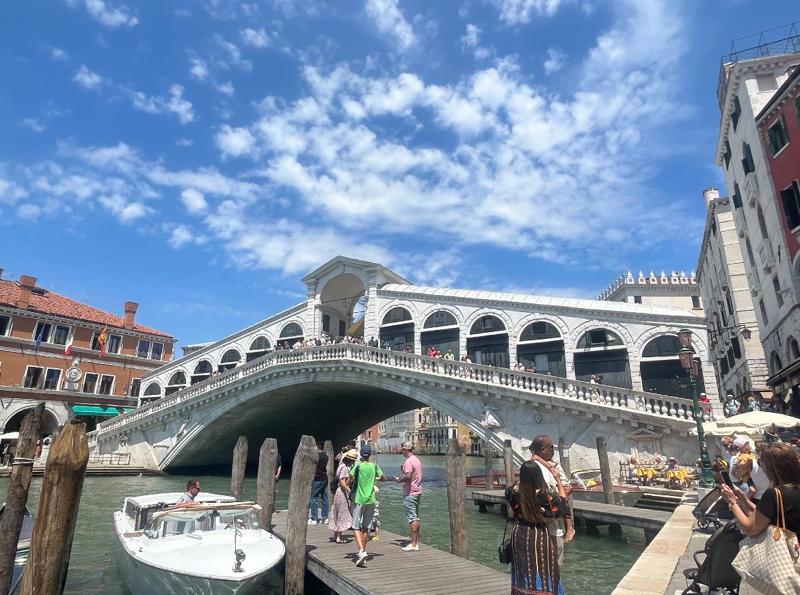
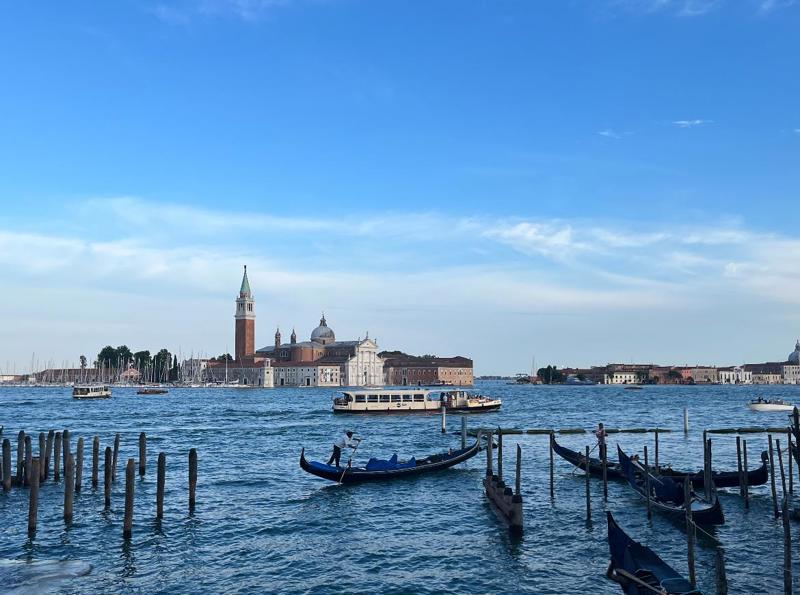
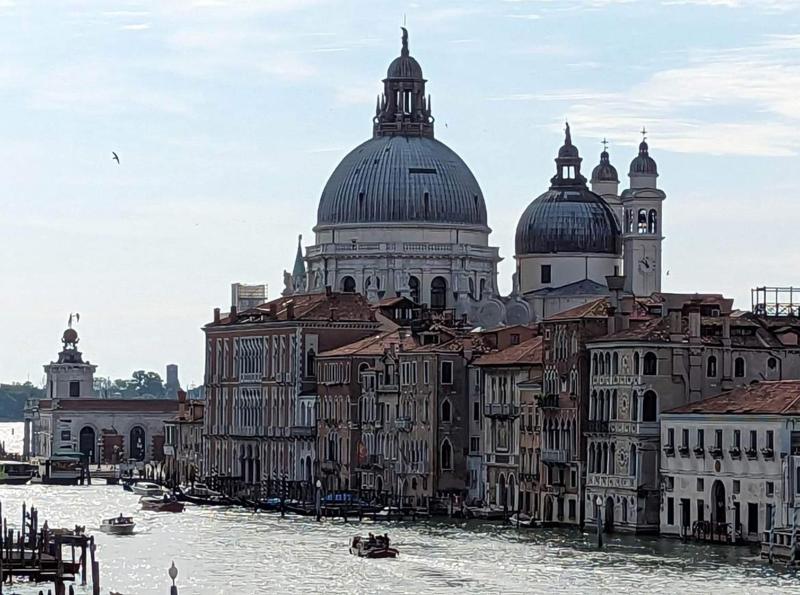
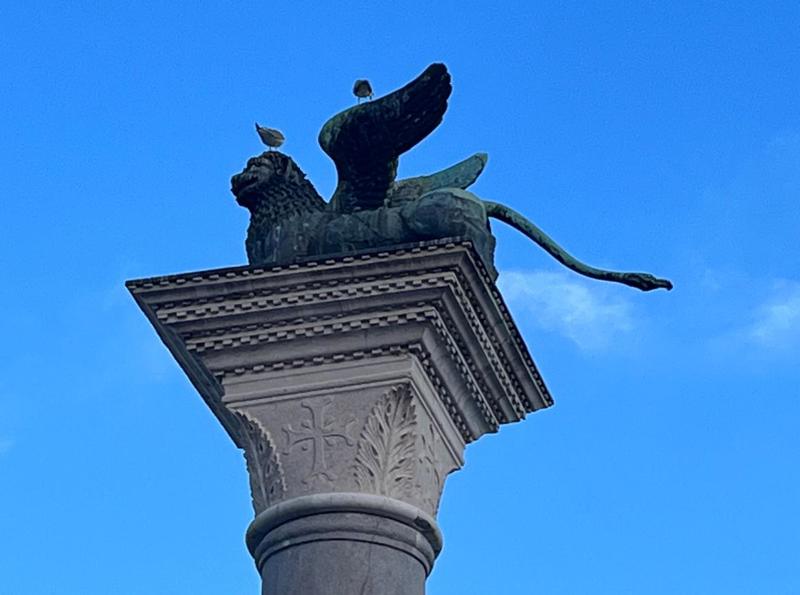

On Thursday, we left Venice and began our drive to Florence - the capital of Tuscany. During the drive we began to see the typical rolling hills and lots of trees.
Upon arrival in Florence, we were joined by a local guide for a walking tour. We were introduced to the Renaissance architecture of Florence with its emphasis on symmetry, proportion, geometry and the regularity of parts.
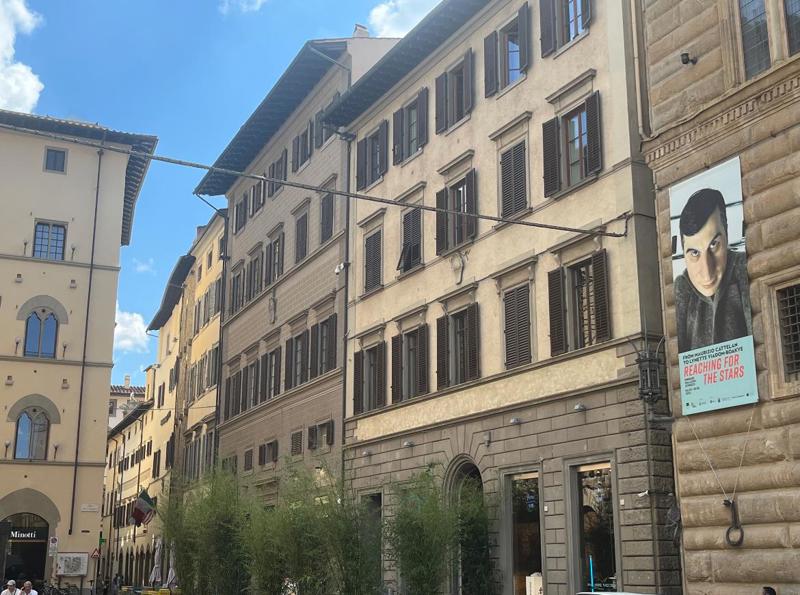
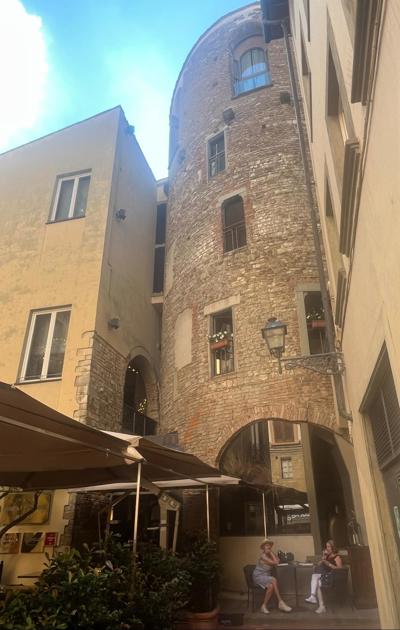
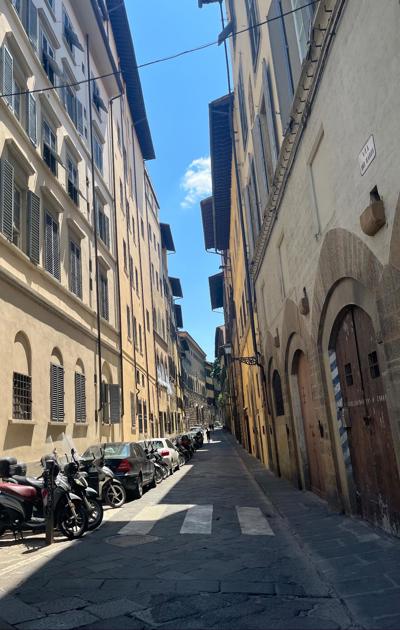
We went to the Cathedral, Il Duomo, a great masterpiece of art. It stands tall over the city with its magnificent Renaissance dome designed by Filippo Brunelleschi, and with the baptistery and Ghiberti’s magnificent doors right across from it.
The exterior of the basilica is faced with polychrome marble panels in various shades of green and pink, bordered by white, and has an elaborate 19th-century Gothic Revival façade. It is breathtaking and huge; pictures simply can’t capture the grandeur.
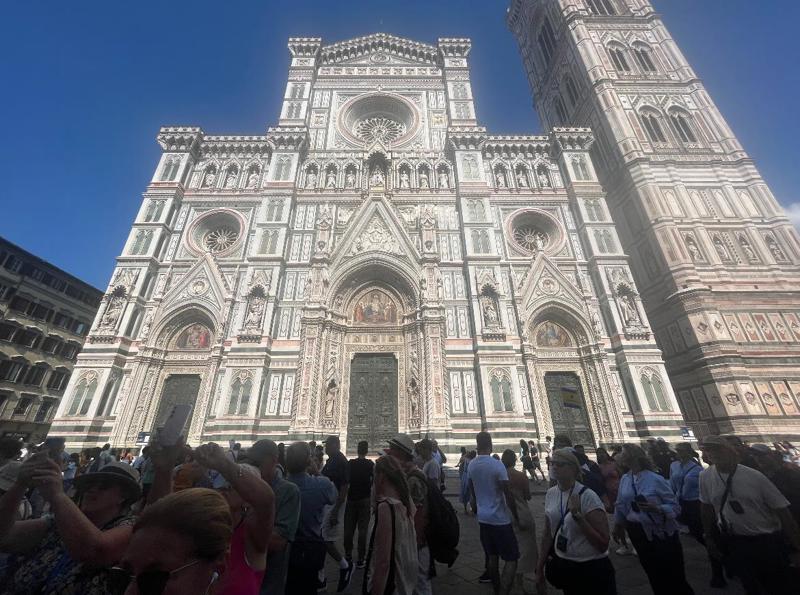
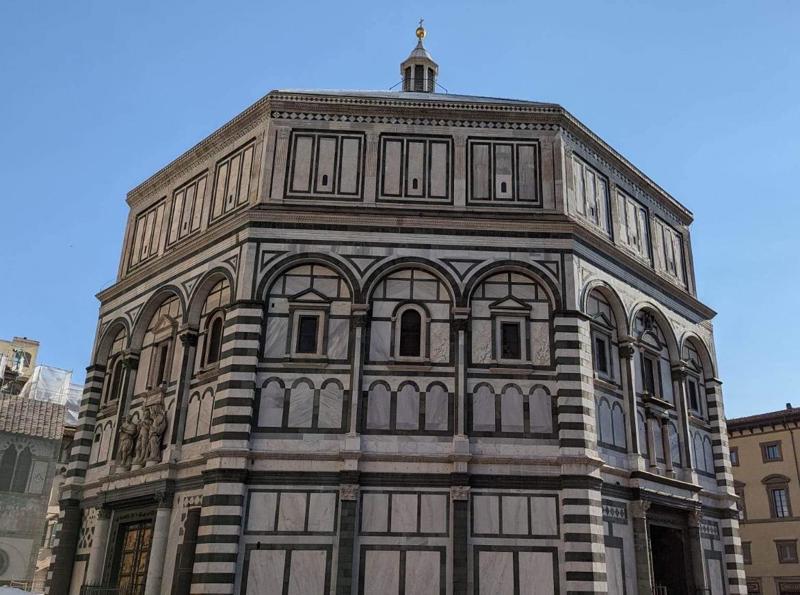
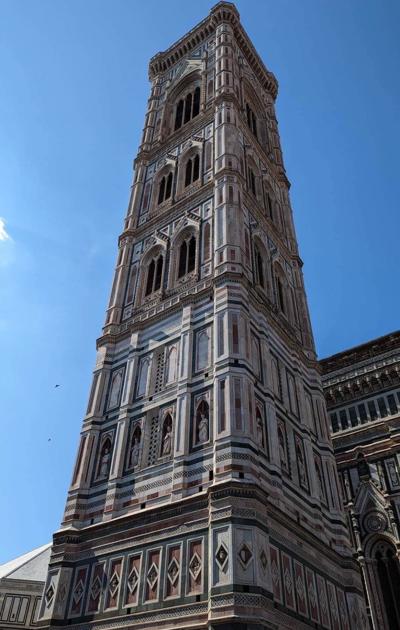
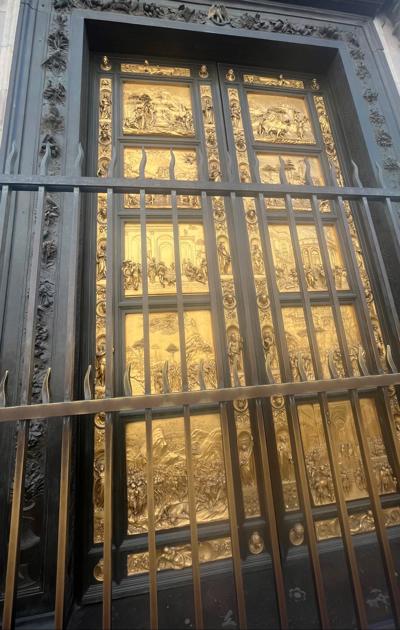
We stopped at Piazza della Signoria, the most beautiful square in the center of Florence. It is famous for its statues, Palazzo Vecchio, a replica of the David and the fountain of Neptune.
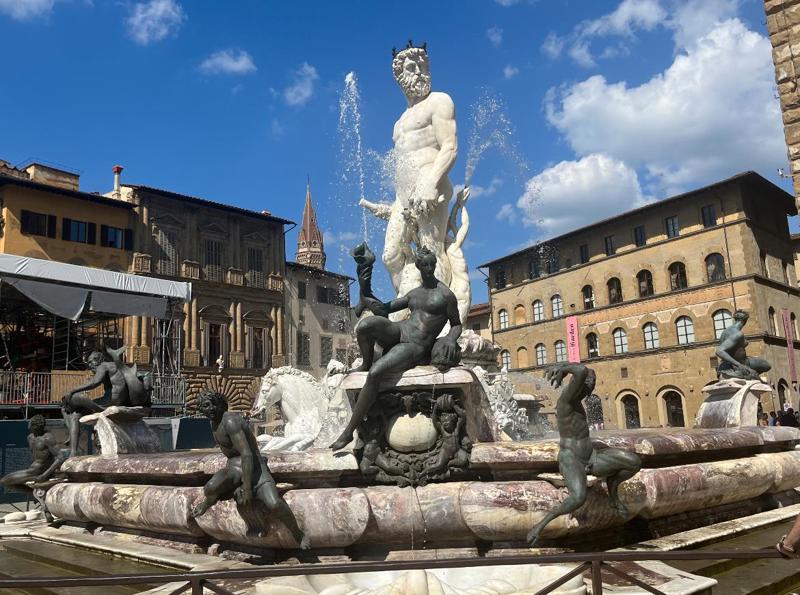
We ended our walk at the Accademia Gallery to marvel at works of sculptural genius: Michelangelo's rough-hewn Prisoners and his greatest masterpiece, David.
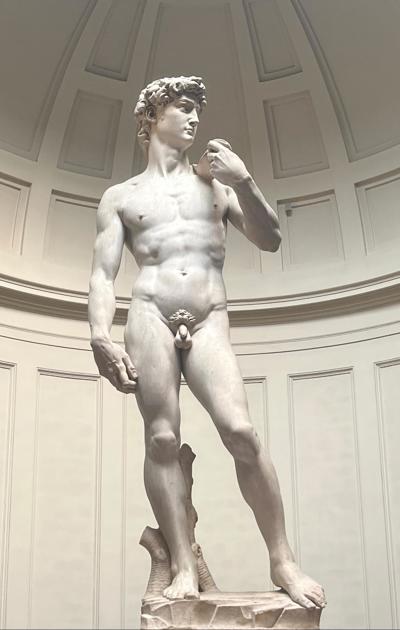
The next day began with an early morning visit to the Uffizi gallery. There we saw works by Leonardo, Botticelli, Michelangelo, Titian, and more. Seeing The Birth of Venus and Leonardo’s Adoration of the Magi (which was never finished) were huge highlights for me.

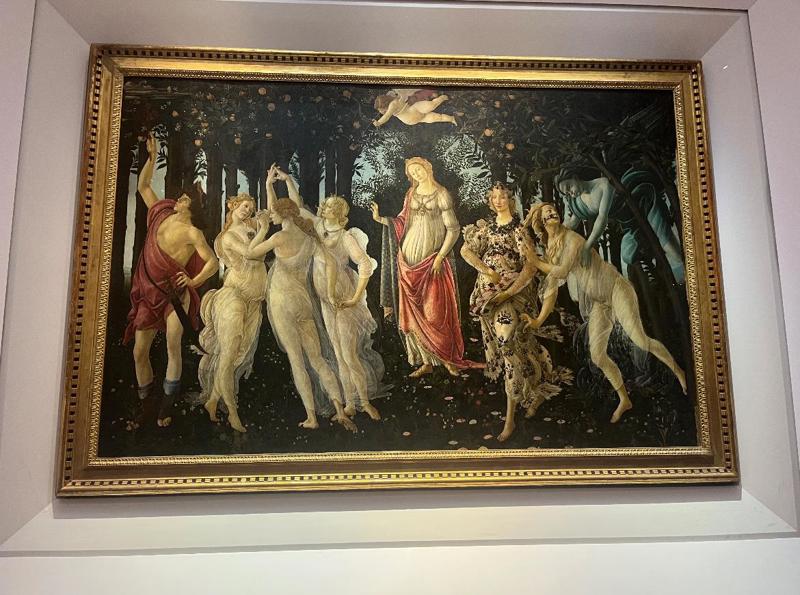
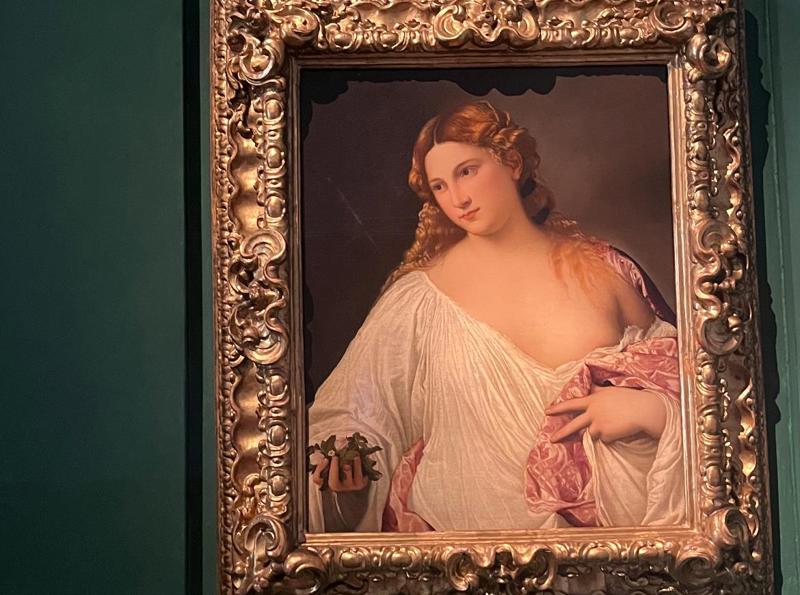
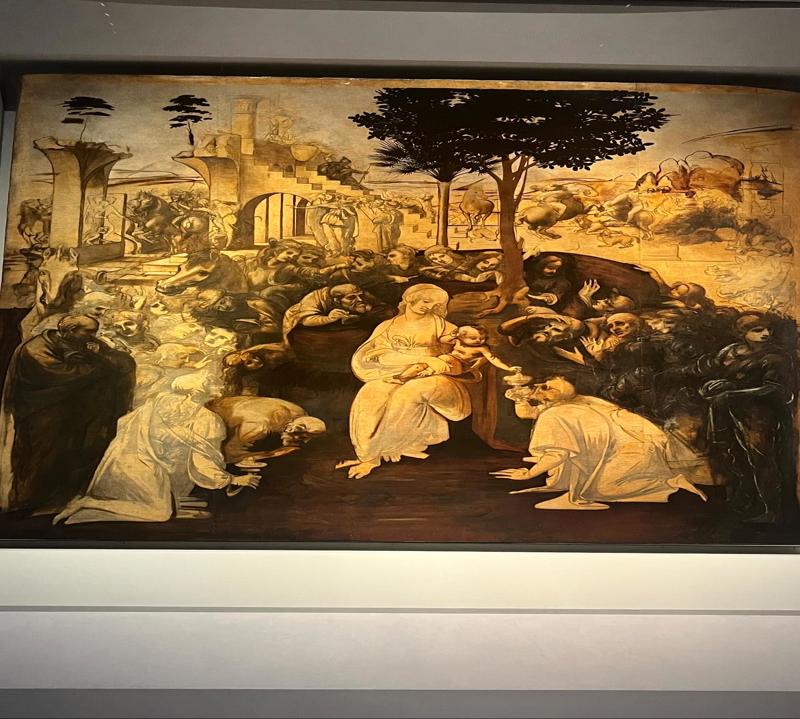
The rest of the day we explored the city. We crossed the Arno river over the Ponte Vecchio - the only Florentine bridge not destroyed during the war. We then wandered streets and churches for a couple of hours and stopped at a quiet restaurant for lunch.
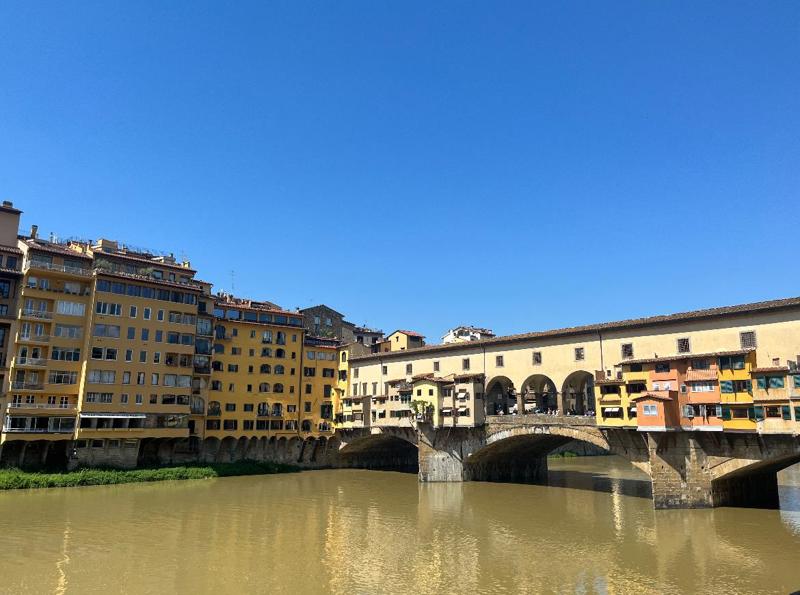
After lunch, we crossed back over the river and visited the leather market and the Medici chapel. The Medicis were an Italian banking family and political dynasty that first consolidated power in the Republic of Florence.
The Medici Chapels form part of the monumental complex of San Lorenzo. The church of San Lorenzo was the official church of the Medici from their period as private residents in their palace in Via Larga, becoming their mausoleum which houses most of the family. The Chapel of the Princes was stunningly beautiful. And, the New Sacristy is a Michelangelo feast with architecture, design and sculpture by the Renaissance master.
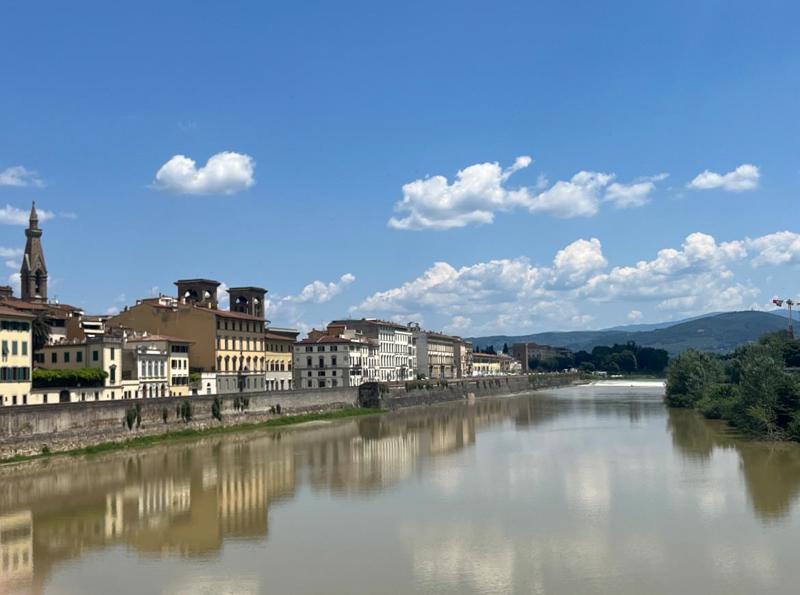
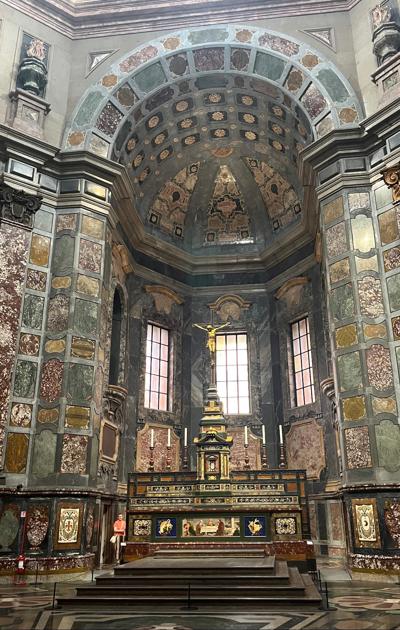
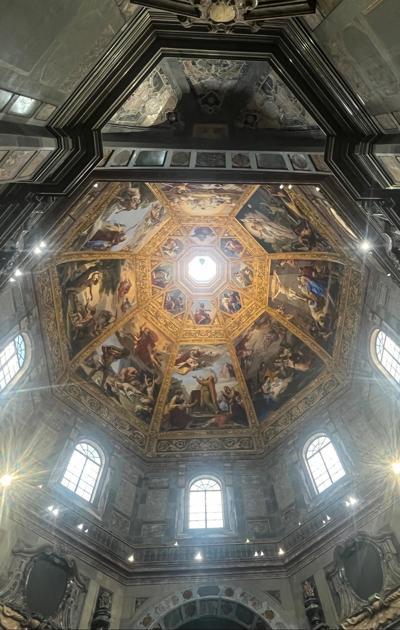
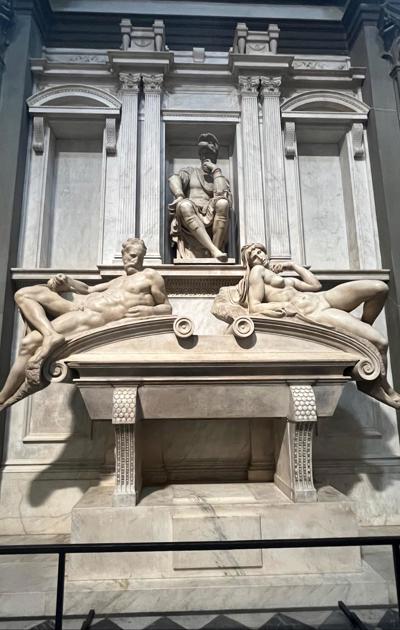
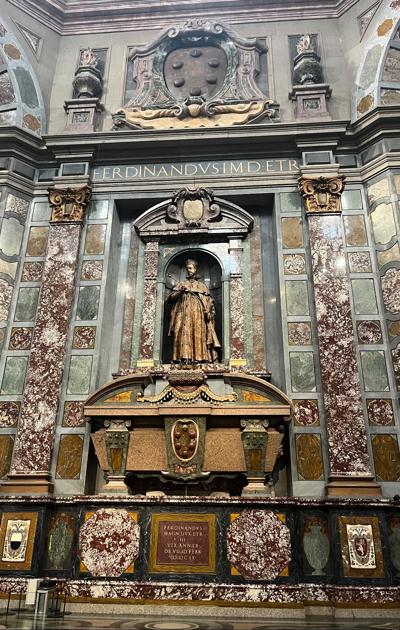
On Friday the 16th, we left Florence and made a stop in Pisa to see the tower. It is the freestanding bell tower of Pisa Cathedral and, along with the baptistery, makes an impressive showing.
The tower began to lean during construction in the 12th century, due to soft ground which could not properly support the structure's weight. Currently, the lean is around four degrees.
I was thrilled to see the leaning tower and the other buildings were beautiful from the exterior, if a little underwhelming inside. (Perhaps I’m spoiled!). The baptistery has magnificent acoustics and we were treated to a short vocal performance which was delightful.
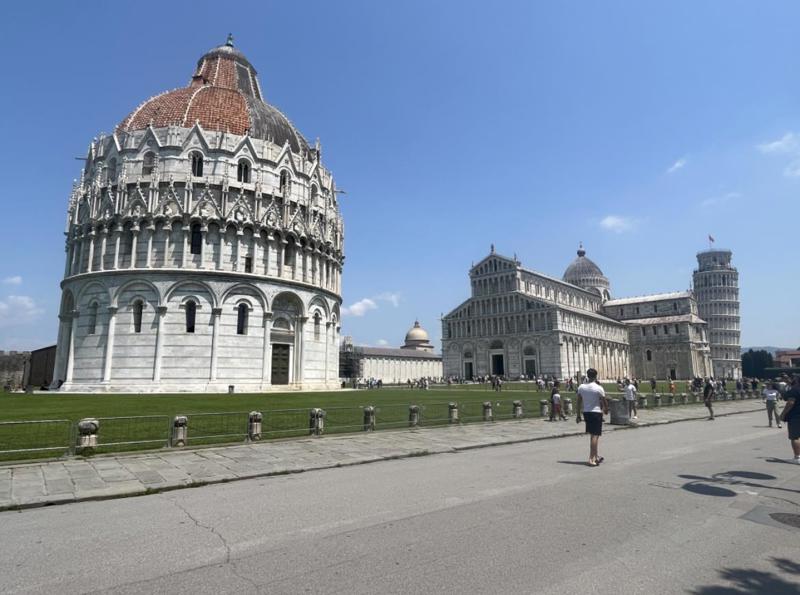
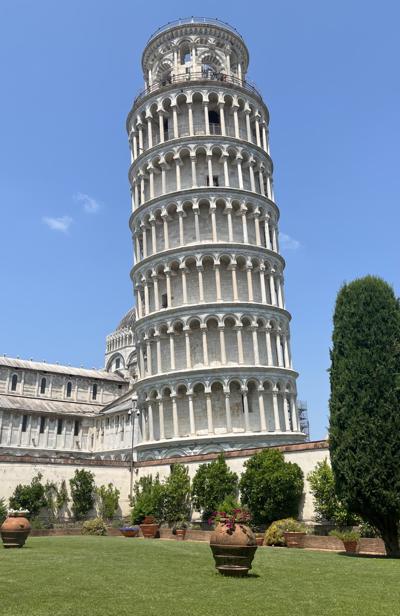
After leaving Pisa, we arrived at the village of Monterosso in the Cinque Terre. It was beautiful and nice break from being in the city. We had a group meal which included a demonstration of pesto making using traditional methods and ingredients. Our dinner included a pesto pasta dish which was delicious.
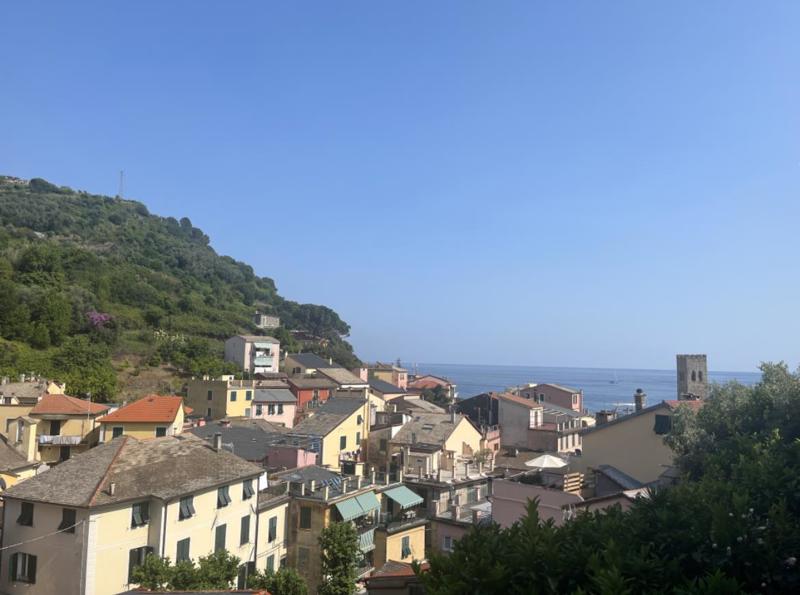
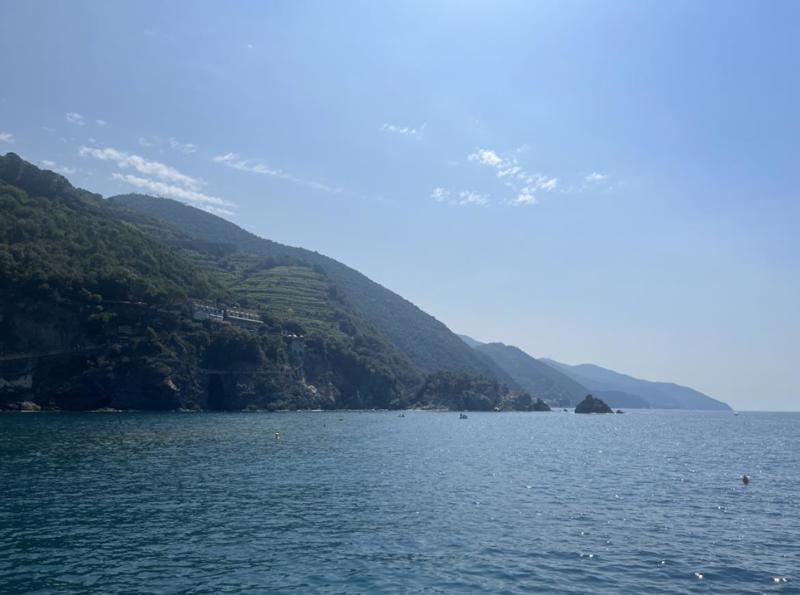
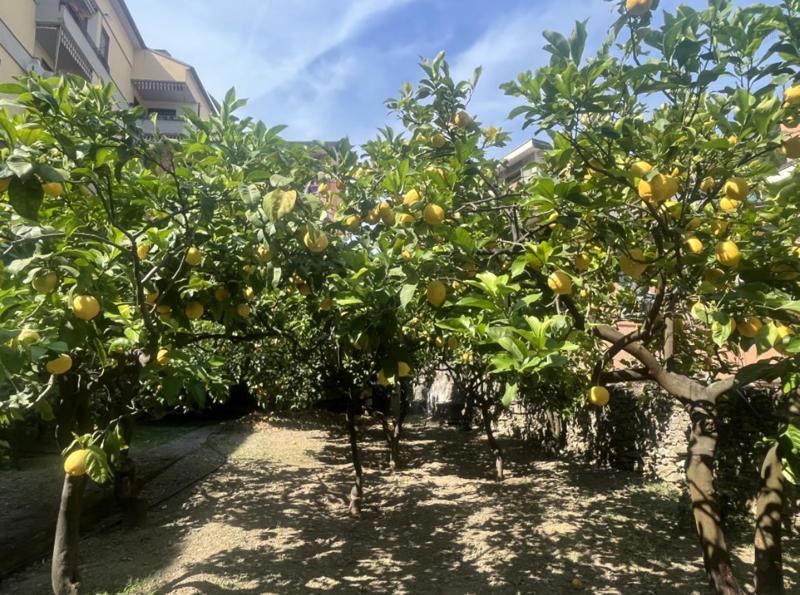
The next morning, we set off by boat to see the other 4 villages - Vernazza, Corniglia, Manarola, and Riomaggiore. We got off the boat at both Riomaggiore and Vernazza to briefly walk around the villages. Then we returned to explore Monterosso and met the group for dinner. We ended the day with limoncello on our balcony.
Our “home” village of Monterosso below and next two pages
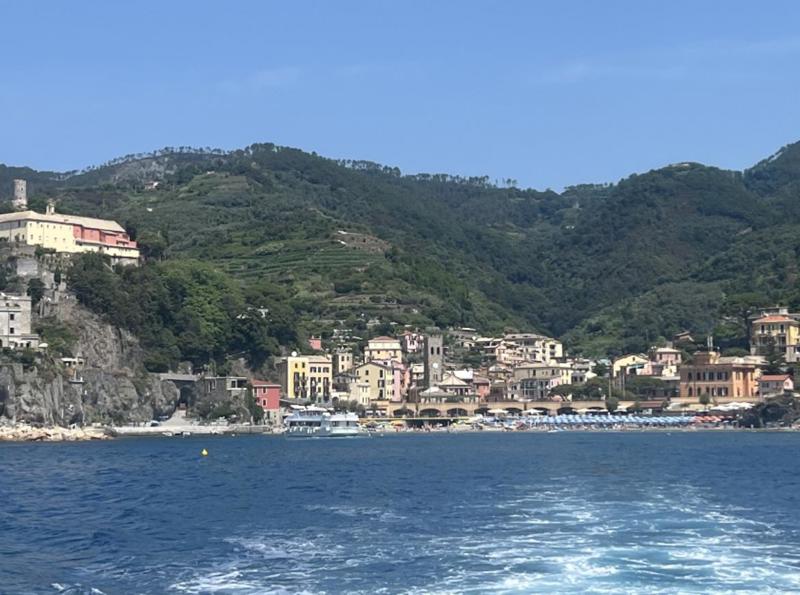
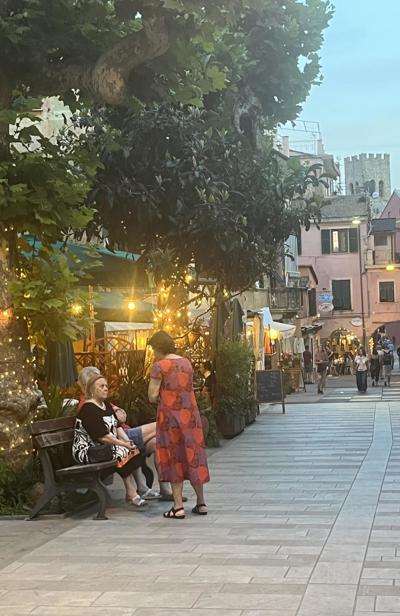
Following page: Vernazza

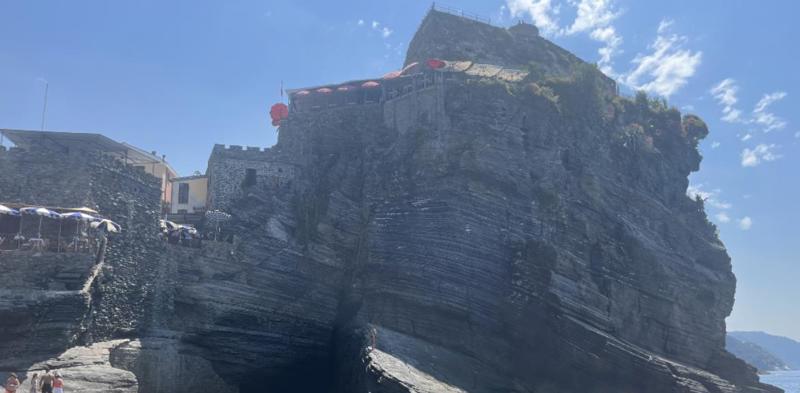
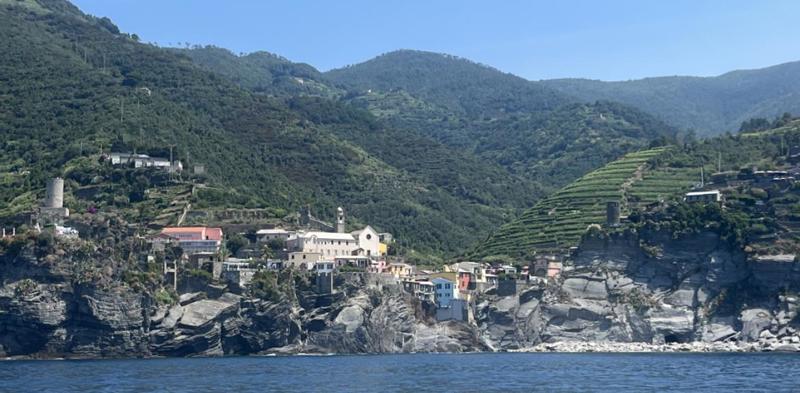
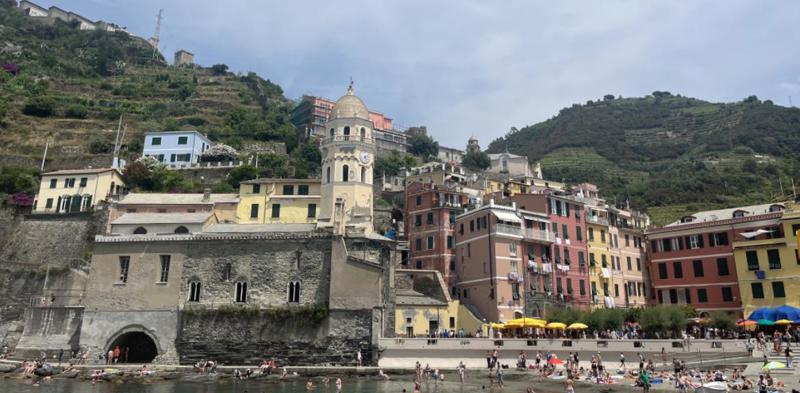
Corniglia

Below: Manarola
Following two pages: Riomaggiore
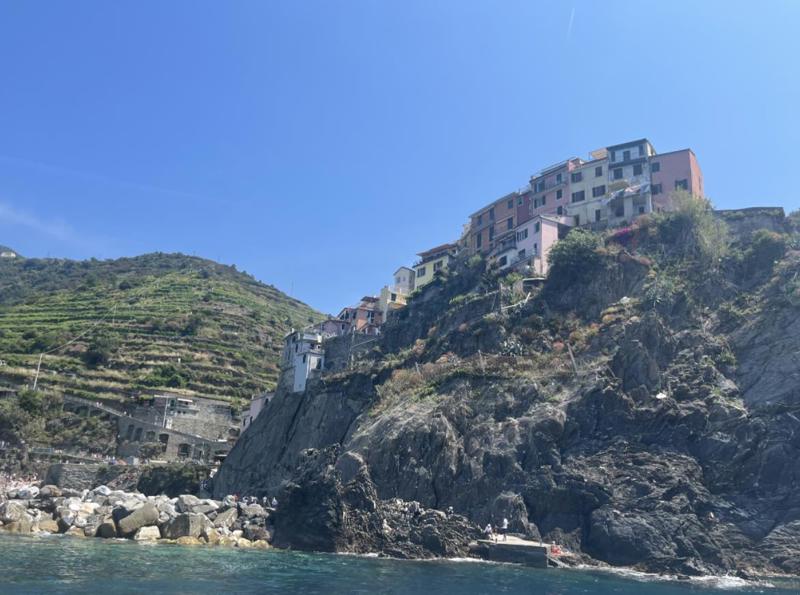
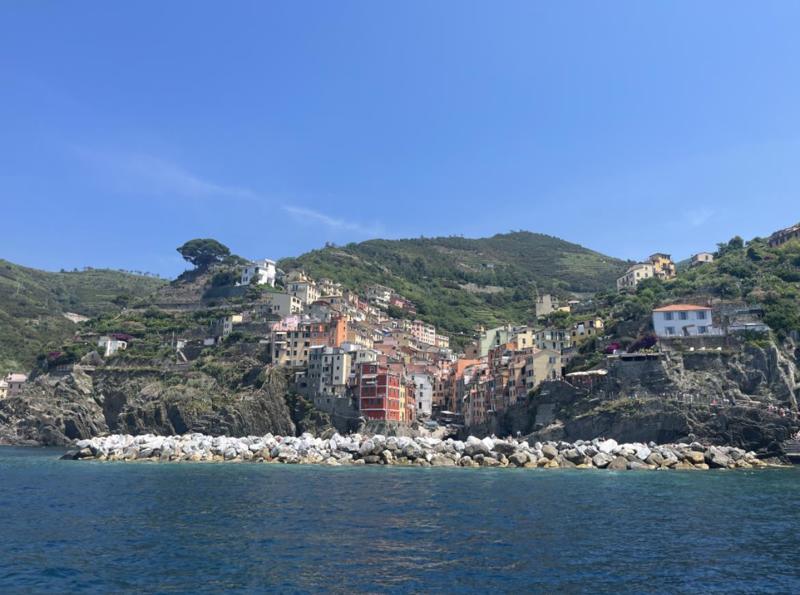
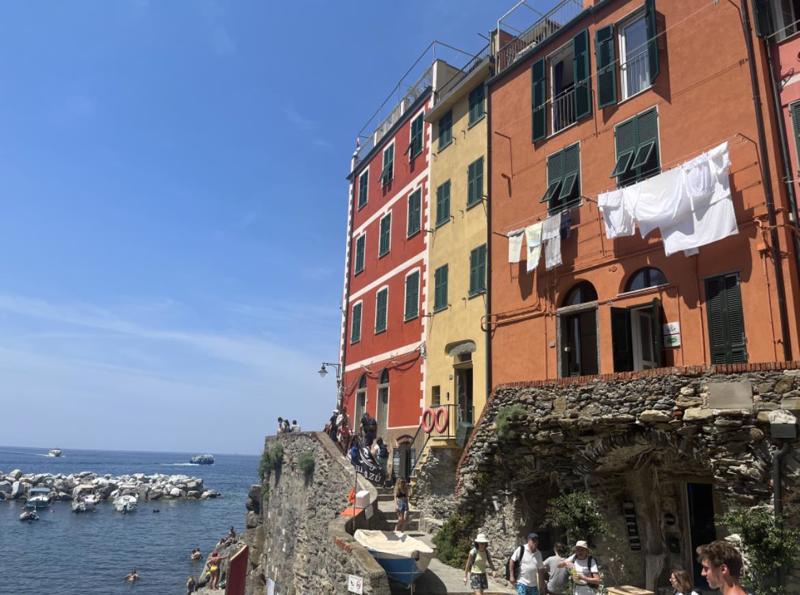
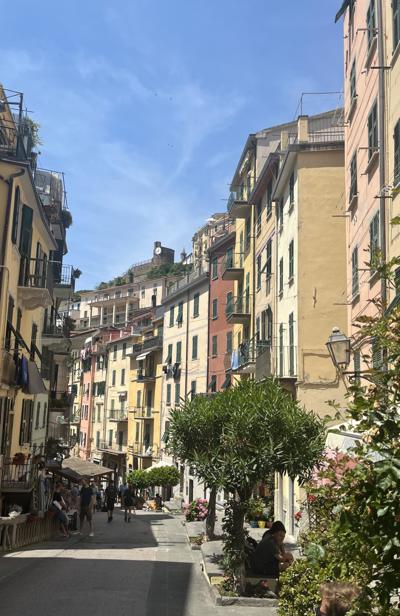
After the weekend in the Cinque Terre, we drove to the hill town of Lucca - passing the Carrara marble quarry en route.
We spent a few hours in Lucca, exploring the streets, squares, and churches. This city has an authentic feel and the architecture was amazing to see. We also saw the amphitheater - Piazza dell'Anfiteatro is a public square with a ring of buildings surrounding the square that follows the elliptical shape of the former second century Roman amphitheater of Lucca.
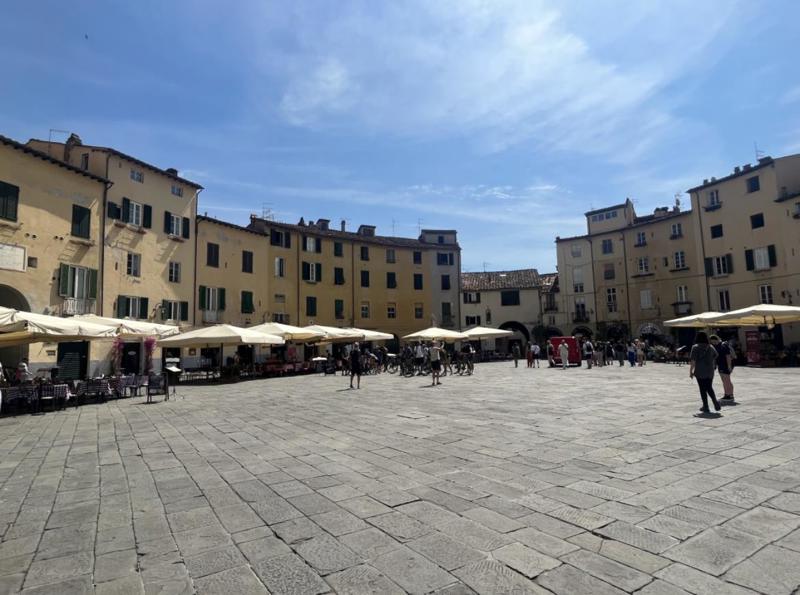
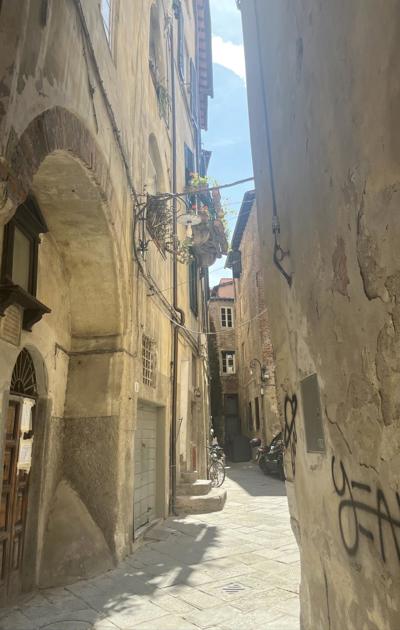
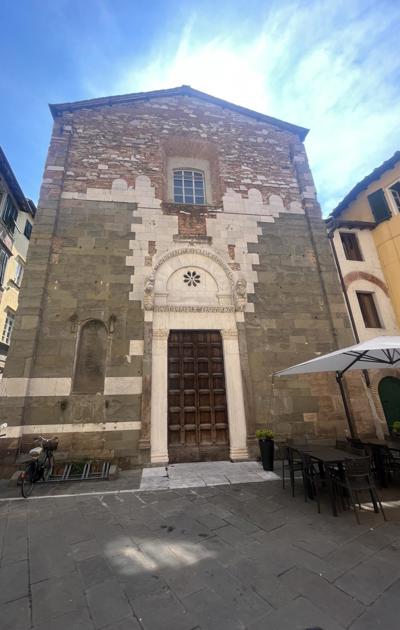
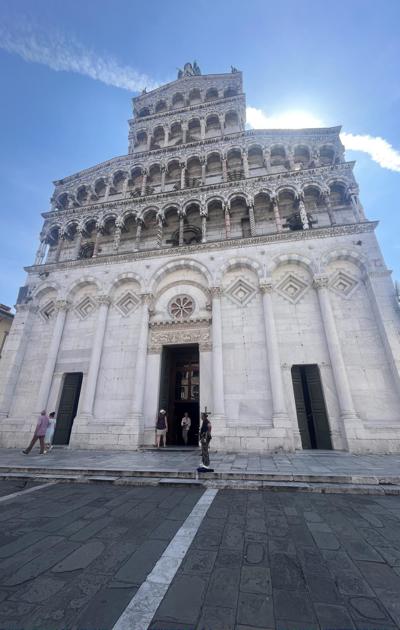
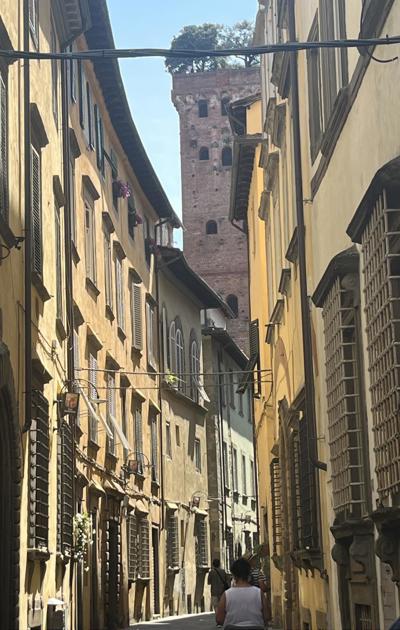
Lucca is a walled city and the wall is wonderfully wide, providing access for walkers and bikers. We walked part of the perimeter and enjoyed views of both the city and the alps.
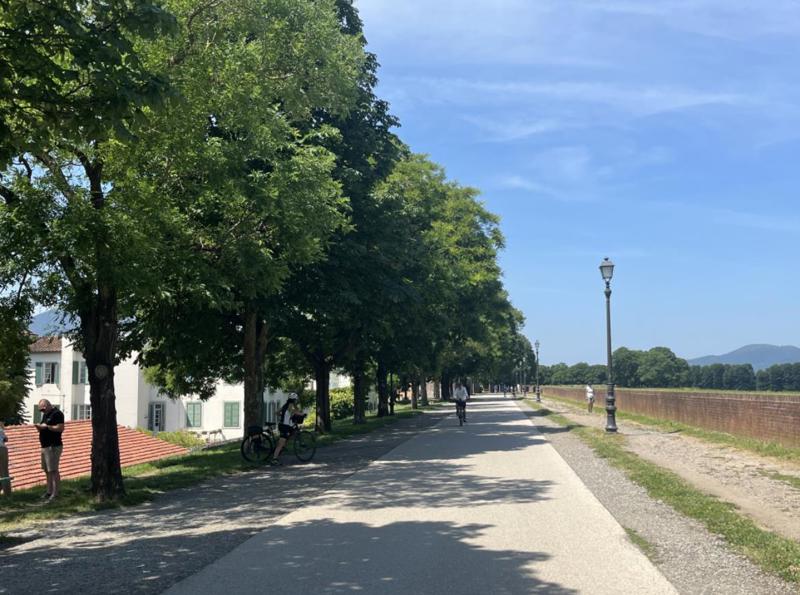
After lunch, the bus took us to the Florence American Cemetery with headstones of 4,392 of the military dead. Most died in the fighting that occurred after the capture of Rome in June 1944. It was a very moving memorial.
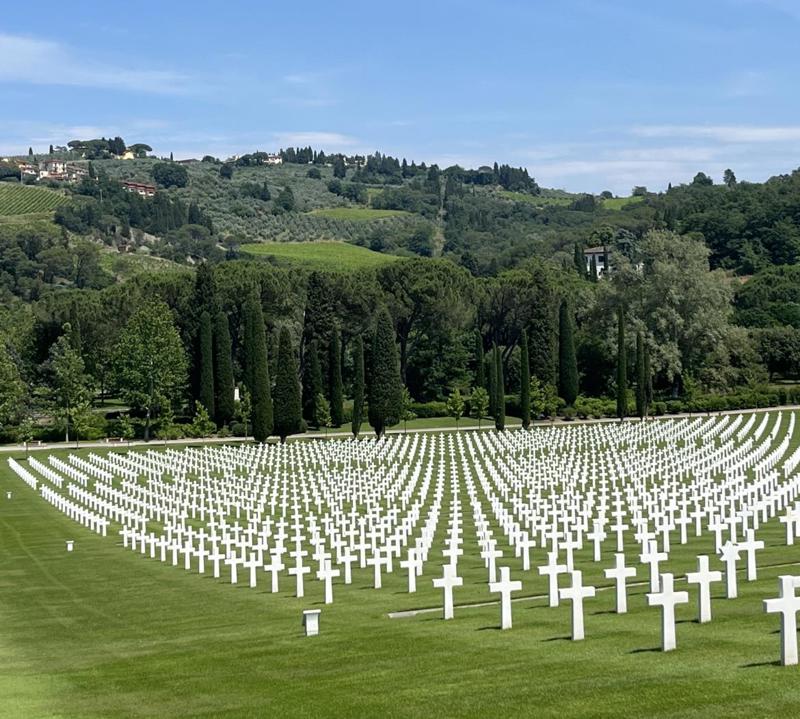
Later, we arrived in the lovely medieval city of Siena - with 50,000 residents. It felt more relaxed and was a nice break in pace after Florence. We began our visit with a walk led by a local guide. Along with interesting architecture, we saw the oldest bank in the world, the Monte dei Paschi bank.
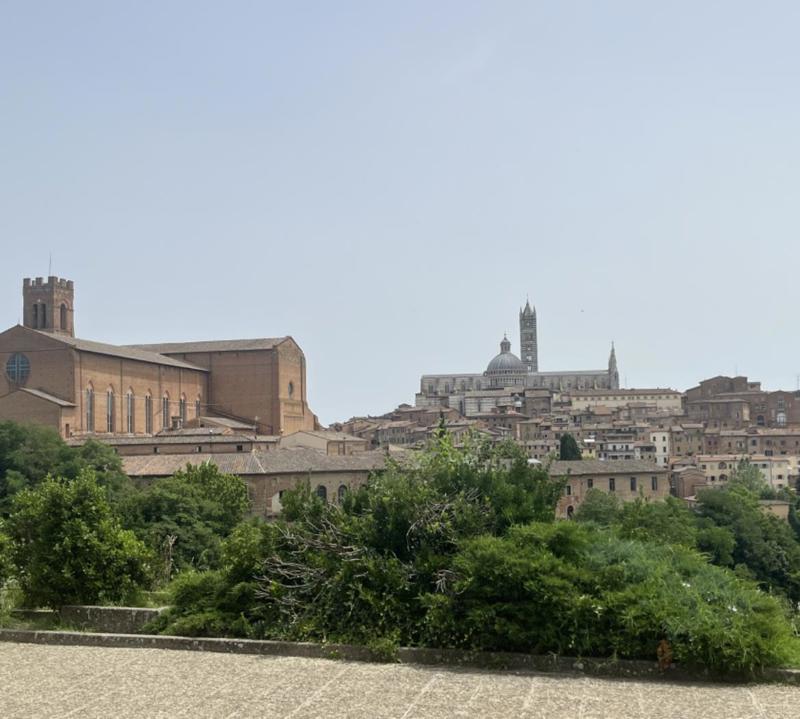
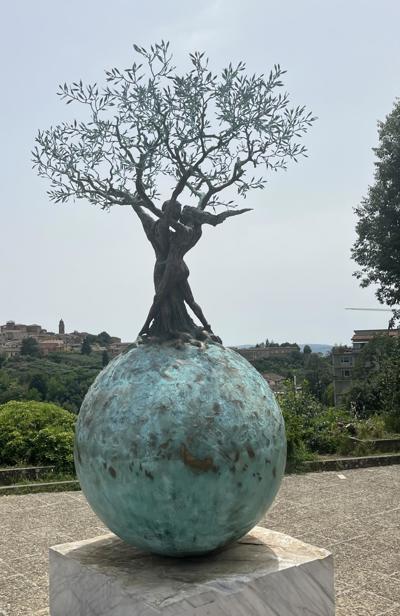
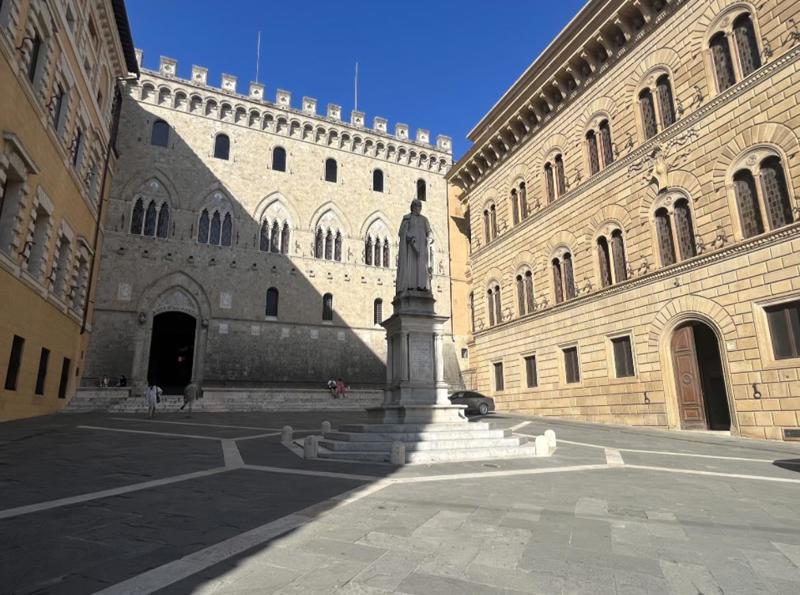
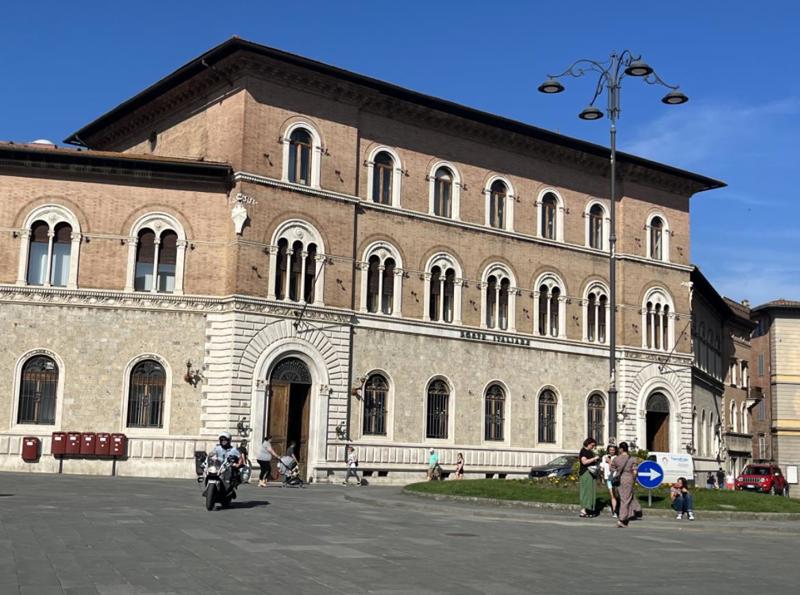
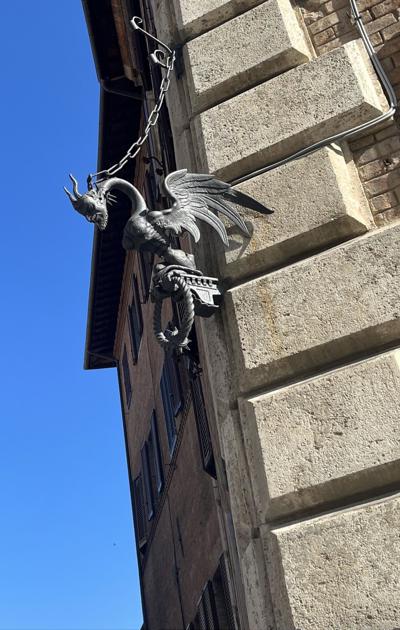
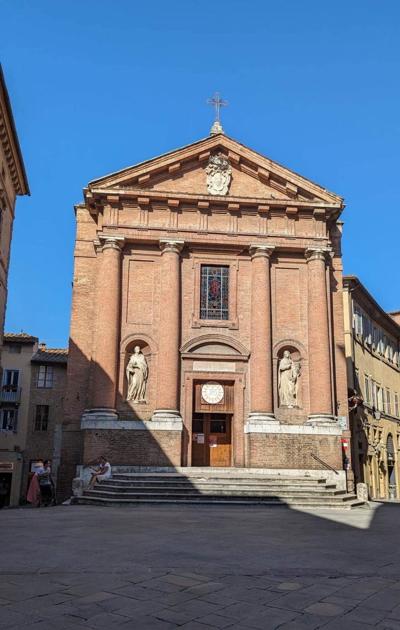
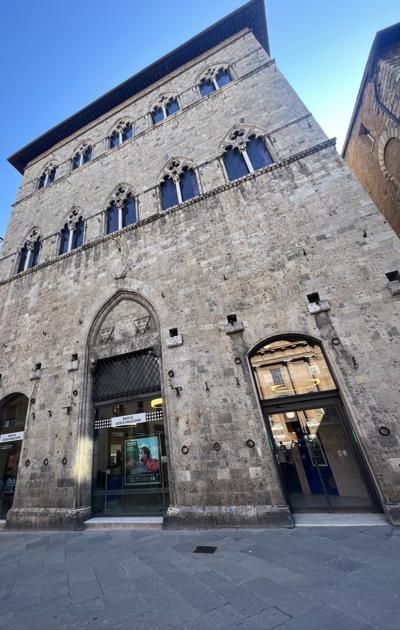
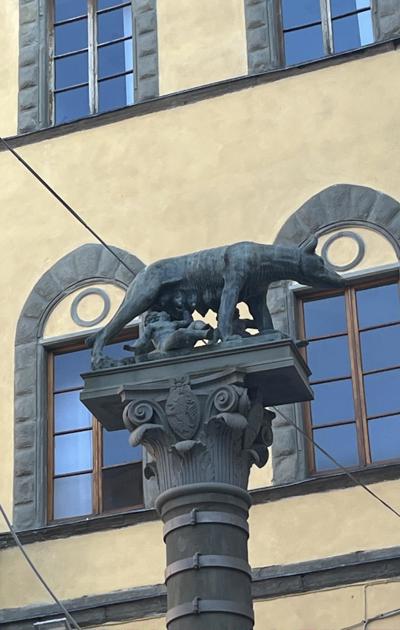
Next we walked to the fan-shaped central square, Piazza del Campo - the site of the Palazzo Pubblico, the Gothic town hall, and Torre del Mangia, a slender 14th-century tower with sweeping views. The city’s 17 historic “contrade” (districts) extend outward from the piazza.
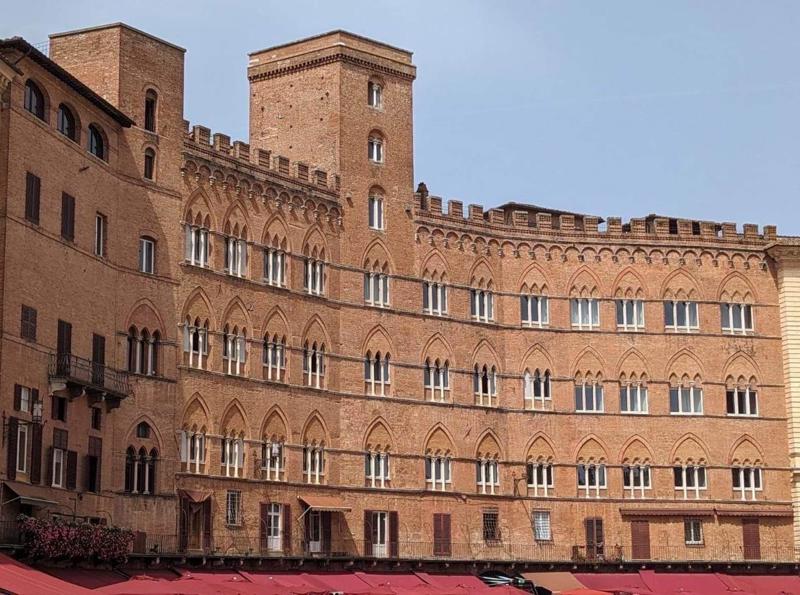
Siena’s history has always been linked to the contrade and the oldest event in Siena, the Palio di Siena. For those who do not live in Siena, it is difficult to understand what the contrade represent: in most cases, there is a tendency to confuse them with the classic neighbourhoods into which a city is divided, which is not completely accurate. For the inhabitants of Siena, the contrade are not mere neighbourhoods, but rather enlarged communities, endowed with their own church and their own Contrada Society. The sense of belonging to this group is deeply rooted in the history of Sienese families. In fact, there are only two ways to be a part of it: by birth or by virtue of belonging to the family itself.
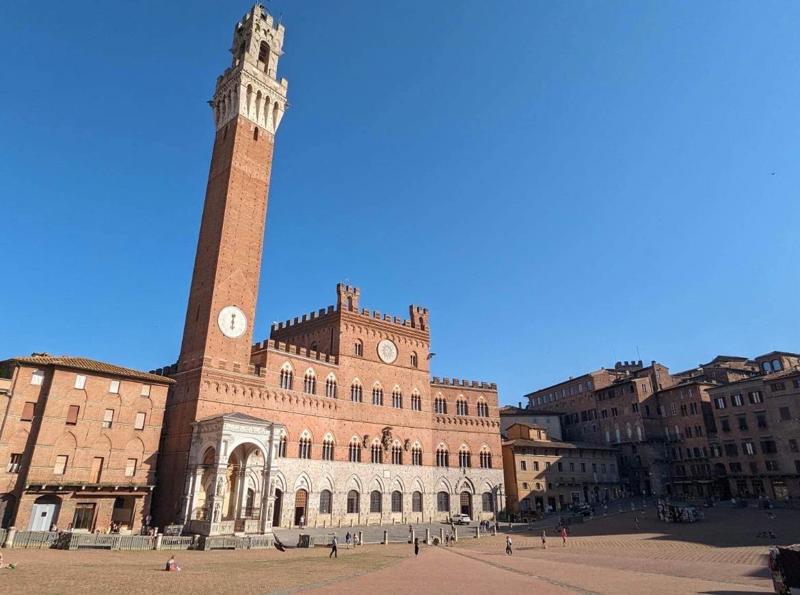
Only 10 of the 17 contrade take part in this event each year, on 2 July and 16 August. Winning the race is a source of prestige and pride for the citizens of the winning contrade.
The Palio de Siena has a unique religious element. We learned that before each race, each contrade’s horse is brought inside their church and blessed with holy water. (Note that when babies are baptized in the contrade, holy water is not used. Priorities!!). Then the horse is led to the race. Whichever horse comes first - with or without its jockey - wins the race. It’s the horse who is key.
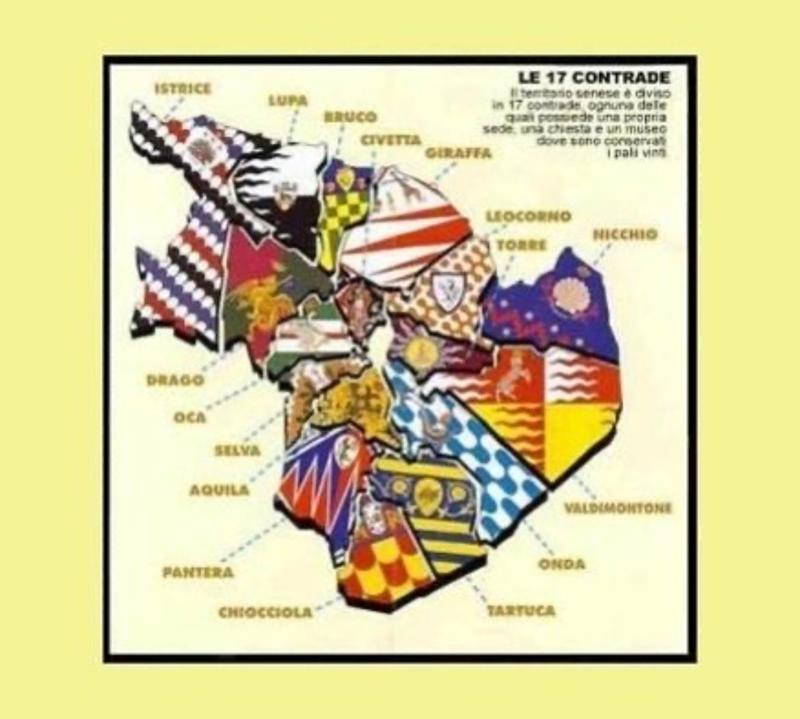
As best I can understand this race, it’s like a strong sports rivalry with a religious overtone. It was great fun to learn about this.
We toured one contrade’s clubhouse and chapel (Selva). They then served us a delicious dinner and we got to see the film of the last race they won - in 2019. This was the winning banner from the race. Each banner must feature the Virgin Mary - a rather sexy one in this case
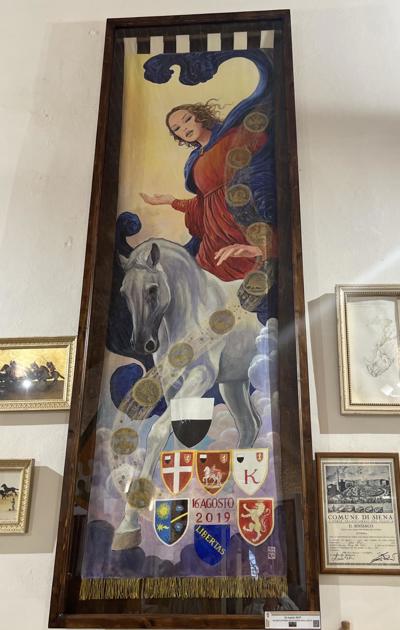
The next morning, we got to see stained glass making using the traditional methods. Fascinating! Then we toured the Siena Cathedral.
Suffering somewhat from ABC syndrome (Another Bloody Church), we avoided churches and museums for most of the rest of the day. We had a picnic lunch in a little park and then wandered the city and did a little shopping.
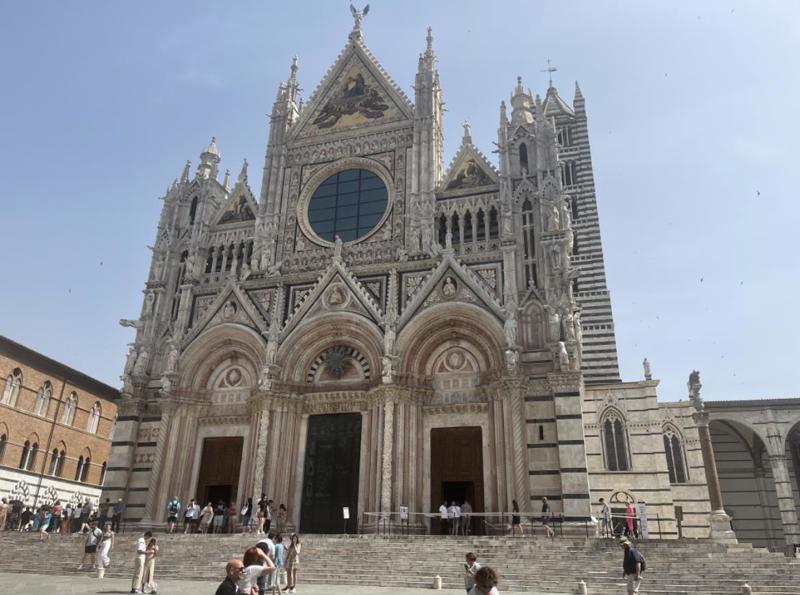
Wednesday we left Siena and drove through the rolling hills of Tuscany and Umbria.
We stopped to visit Assisi. While I’m not into religious iconography and value visiting churches purely for their historical and artistic elements - seeing Assisi was meaningful to me. I appreciate St. Francis’ devotion to animals and the environment.
First we stopped at Santa Maria Degli Angeli. Built in the Baroque style between 1565 and 1685, its vast interior houses the Porziuncola chapel, a humble stone church where St Francis first took refuge after he'd renounced
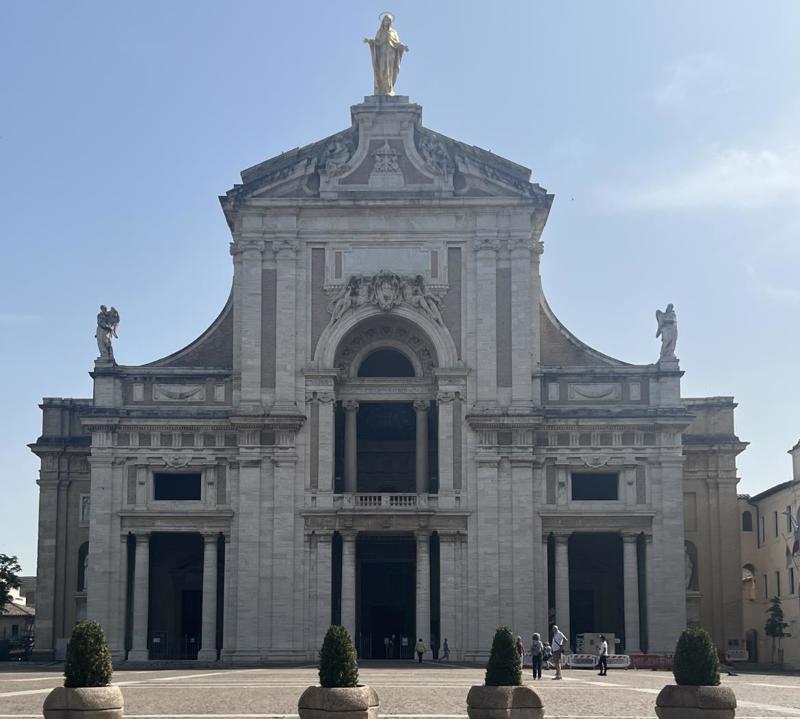
his worldly goods, which is generally regarded as the place where the Franciscan movement started. Nearby, the Cappella del Transito stands on the site where St Francis died.
We then drove further into town, explored a little and had lunch. A local guide met us next for a walk through town, explaining its history and architecture. Assisi is a lovely little hill town with magnificent views and lots of quirky buildings.
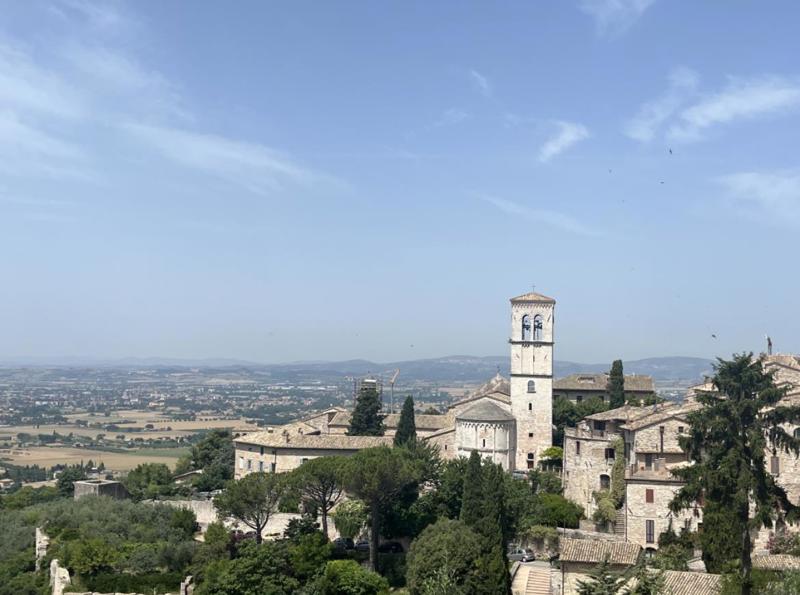
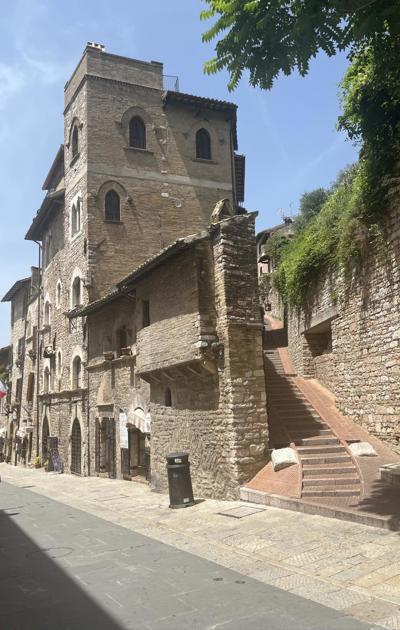
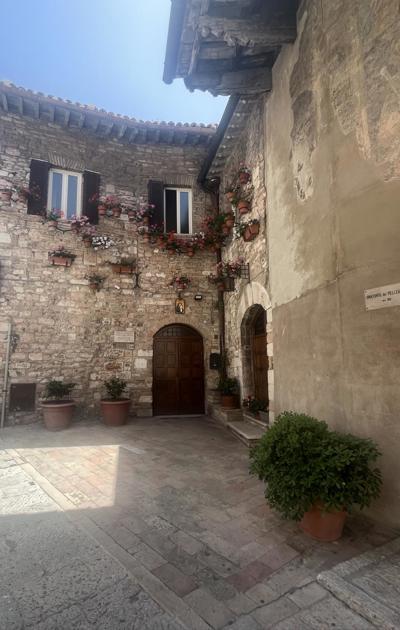


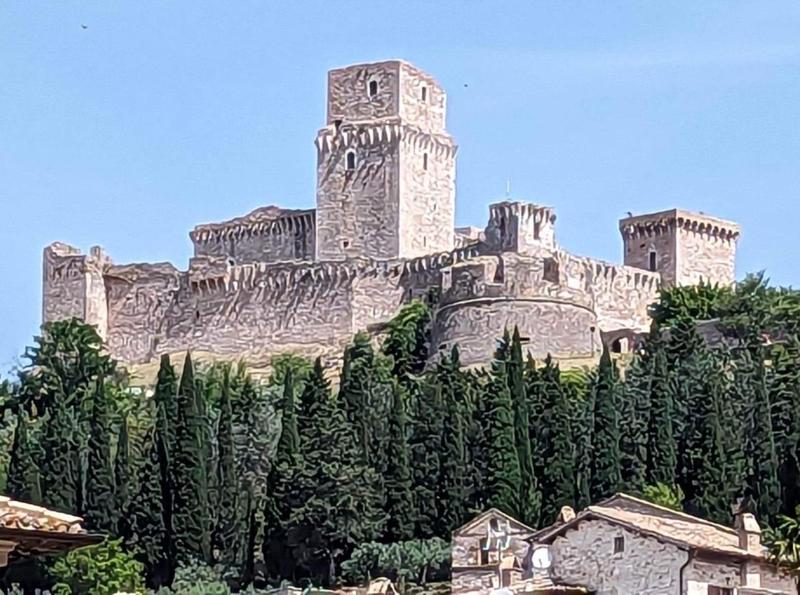

Our guide took us to the Basicilica of St. Francis of Assisi - an important place of pilgrimage for many.
The Basilica of Saint Francis of Assisi is a World Heritage site that contains the Saint's tomb and the masterpieces of Giotto. The interior is stunning; unfortunately no photos are allowed. We saw Francis’ tomb and the frescoes which tell the story of his life - at least the way the church wanted it to be portrayed. I suspect it’s not the way Francis would have chosen to be memorialized.
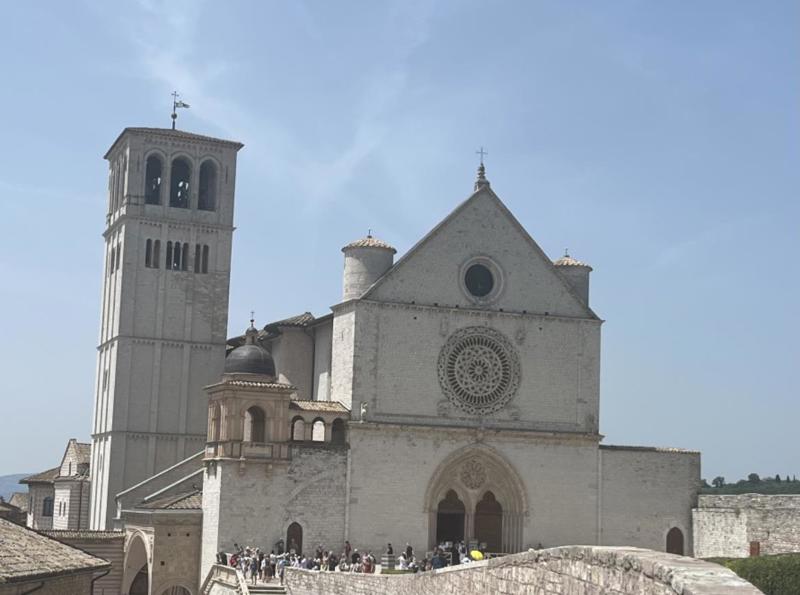
Next we drove to the wine resort where we are staying for the next two days.
The resort is lovely. It’s quiet and calming being in nature. We had a tour of the vineyards, sampling the organic wines and then enjoyed a wonderful four course meal.
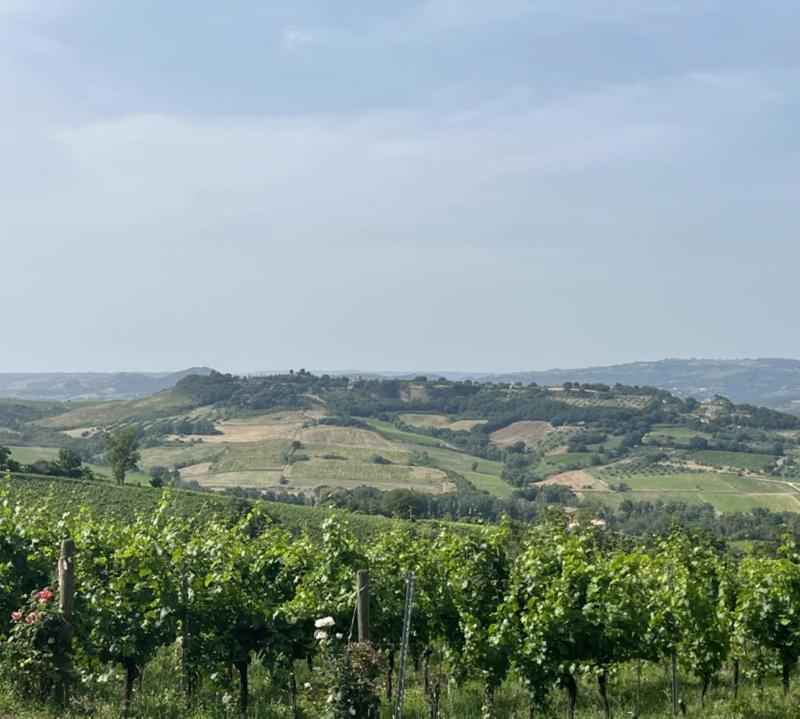
On the morning of June 22nd, some of us took a drive to the small hilltop town of Orvieto. It felt, by far, like the most authentic town we’d been in. There were tourists, but still many locals.
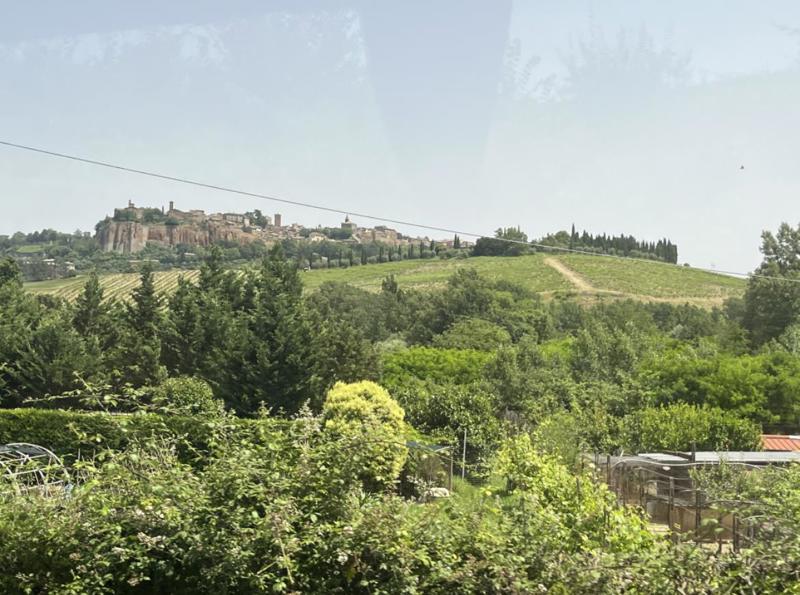
We visited the church where inside reside two frescoed chapels decorated by some of the best Italian painters of the period.
It has very unique windows with stained glass combined with alabaster. The alabaster panes in the bottom parts of the aisle windows keep the interior cool during the fierce Italian summer.

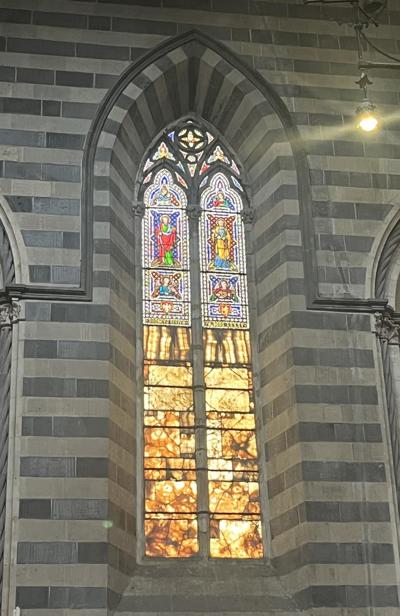
Of particular value and beauty are the frescoes by Luca Signorelli in the Cappella di San Brizio (San Brizio chapel) where the artist plays with skill and very engaging choreography, the theme of the Last Judgment, in a striking alternation of apocalypse and redemption.
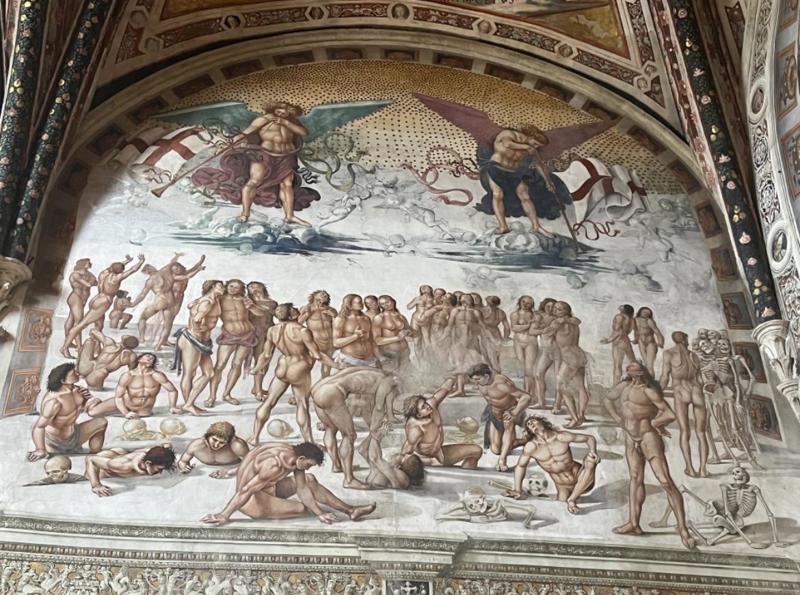

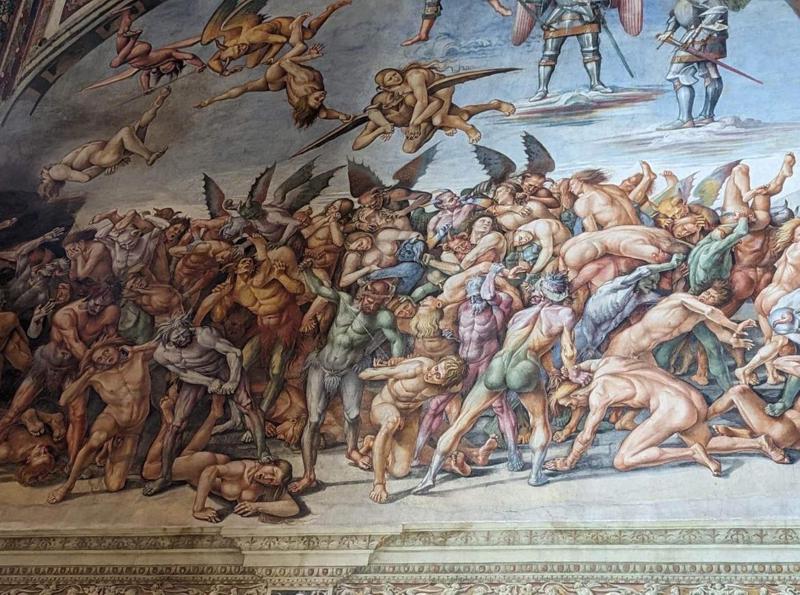
After that, we did a little shopping (because what better to follow the apocalypse?) and visited the Etruscan museum. Later we went back to the resort to enjoy drinks by the pool in the 96 degree heat.
Later, we meandered down the path to another lovely meal before we prepared to head to Rome.
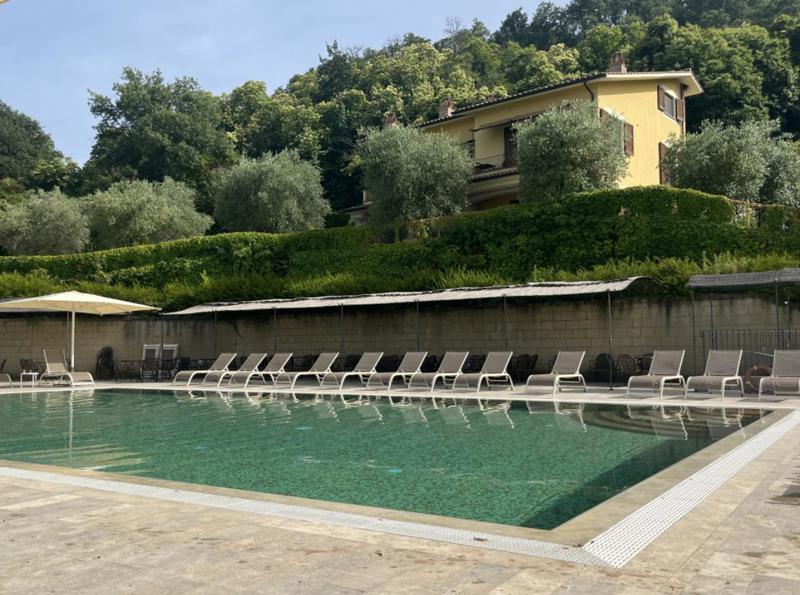
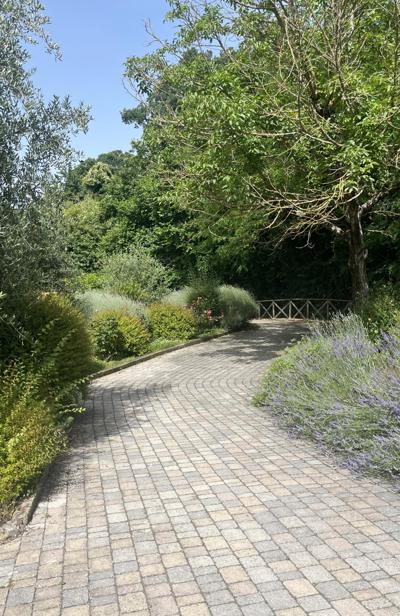
It was amazing to be in Rome. But, the two days we were there were very hot and intense. We walked miles. After arriving on Friday and checking in to our hotel, we took the city bus to the pantheon.
The pantheon is a striking 2000-year-old temple, originally commissioned as a temple to all the gods but now a church. It is the best preserved of Rome’s ancient monuments. It is beautiful inside and felt very calming. The dome, with its open oculus, is as the Romans left it; no restoration has occurred. It is a beautiful relic of Ancient Rome.
After spending time inside the building, we enjoyed lunch at a cafe with a view of the exterior.
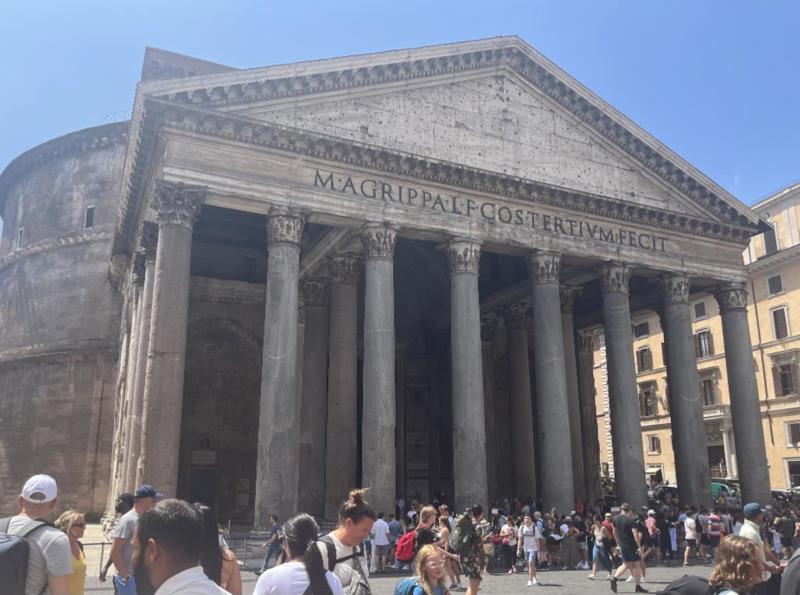
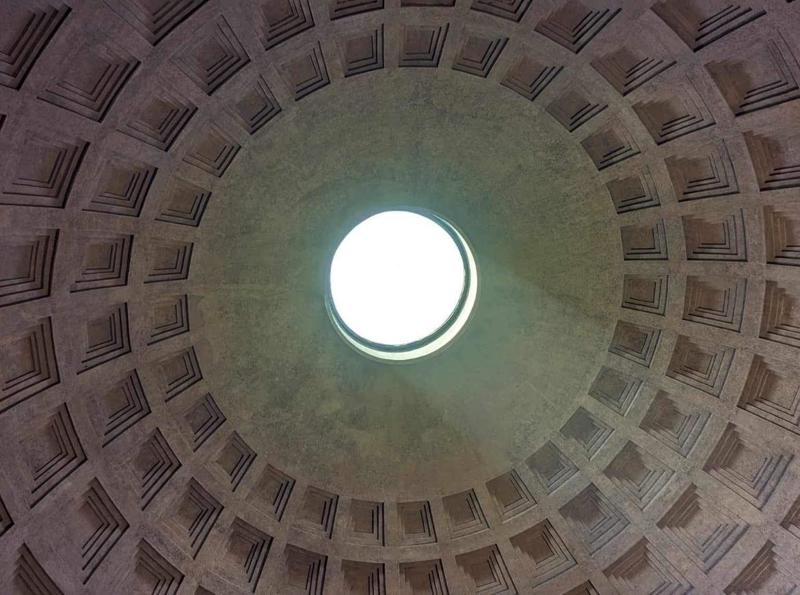
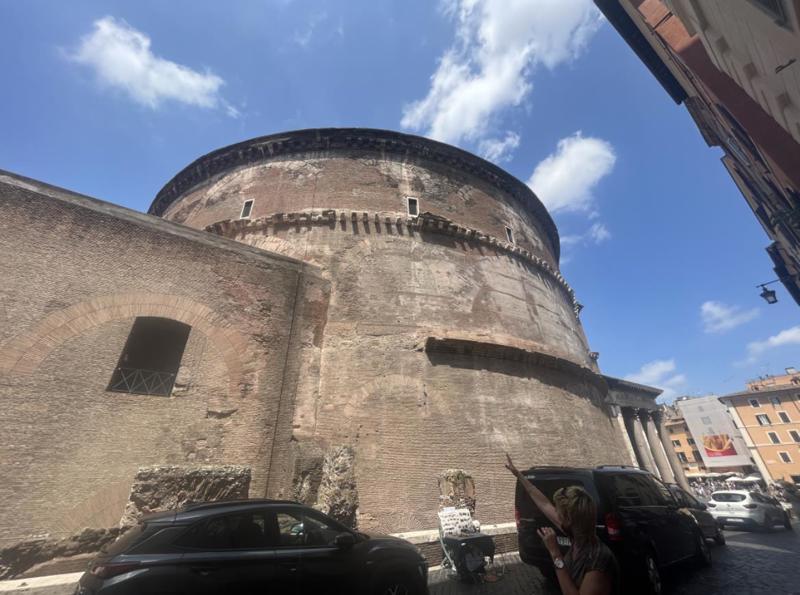
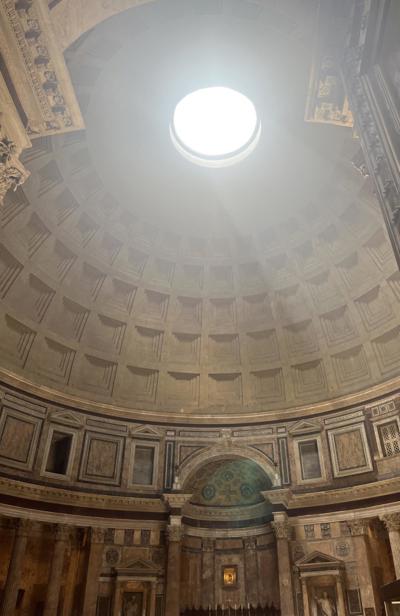
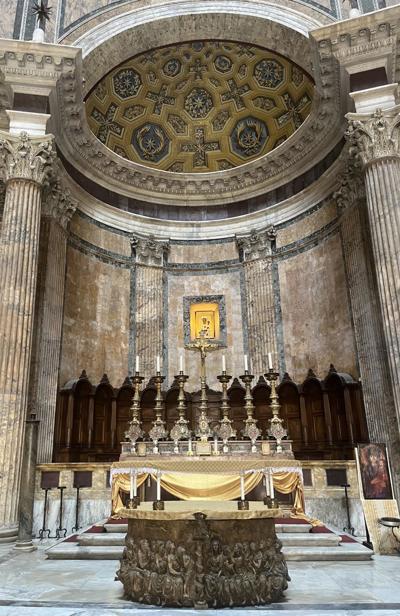
After lunch, we walked to the forum where we were joined by a local guide.
An impressive sprawl of ruins, the Roman Forum was ancient Rome's showpiece center, a grandiose district of temples, basilicas and vibrant public spaces.
The Roman Forum was the pulsing heart of Rome, the city’s main piazza where citizens of every social level met to exchange opinions, do business, buy in the markets and renew their strength over a tasty dish and a cup of good wine.
We saw the ruins of numerous temples and buildings including the Temple of Castor and Pollux and the Arch of Tutus which links the forum and the colosseum. We also learned about the vestal virgins and saw where they lived.
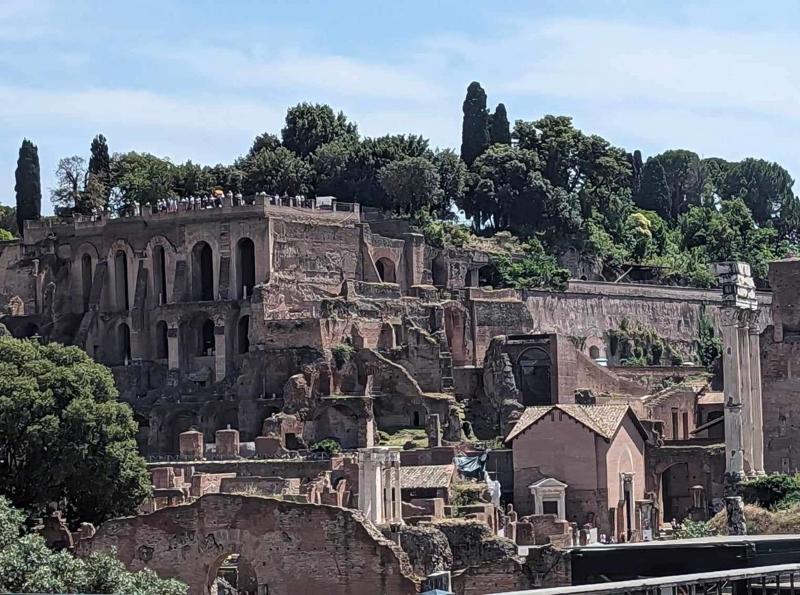
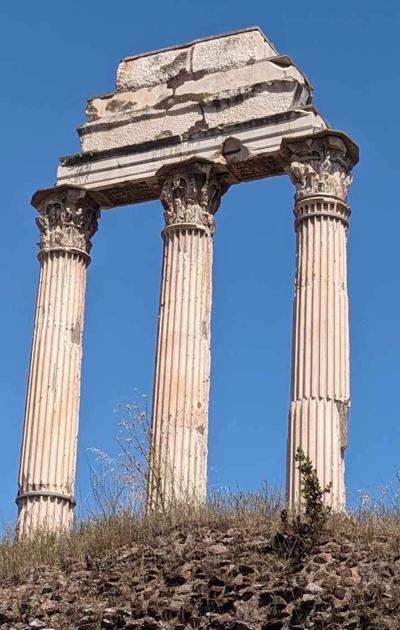
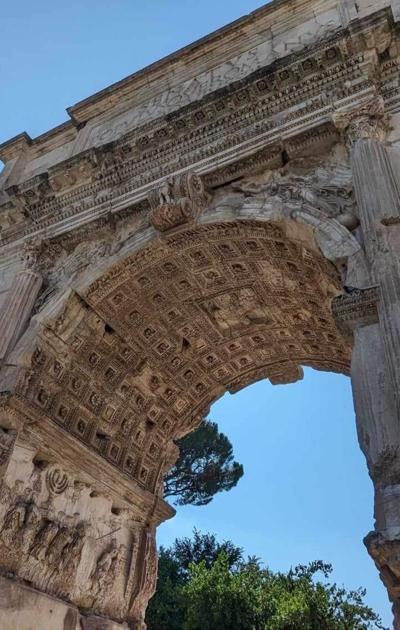
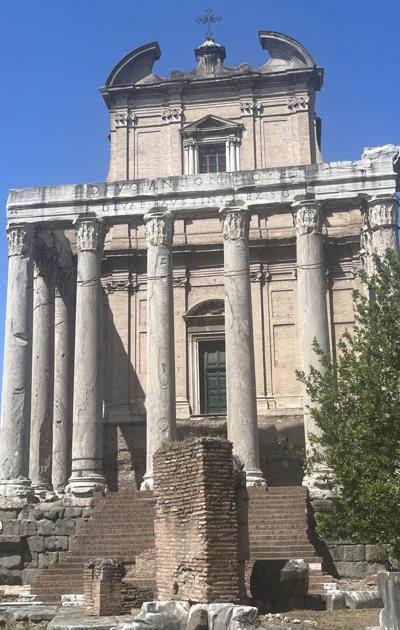
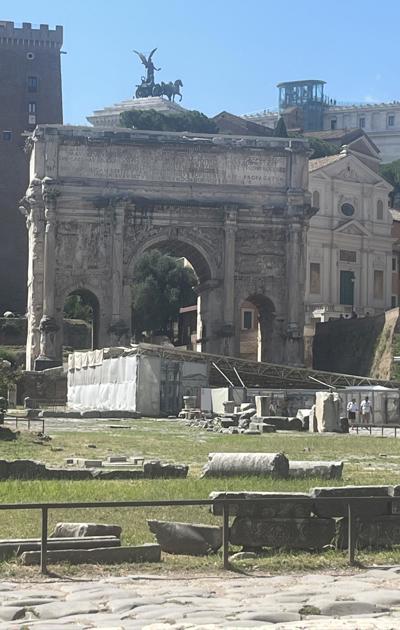
From the forum, we went to the colosseum - an elliptical amphitheatre in the centre of the city. It is the largest ancient amphitheatre ever built, and is still the largest standing one in the world, despite its age. It could hold an estimated 50,000 to 80,000 spectators at various points in its history. It was used for gladiatorial contests and public spectacles including animal hunts, executions, re-enactments of famous battles, and dramas based on Roman mythology.
Standing inside, knowing the history of what transpired there, was awe inspiring and a little surreal.
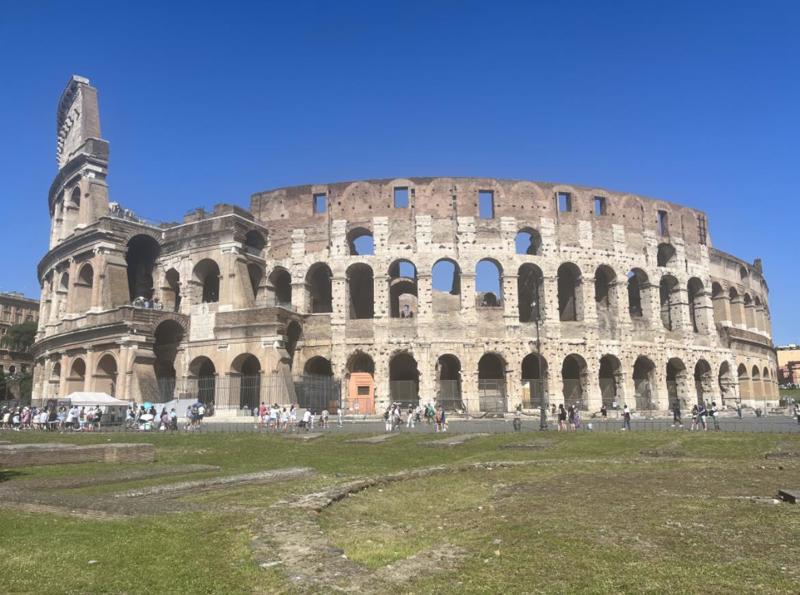
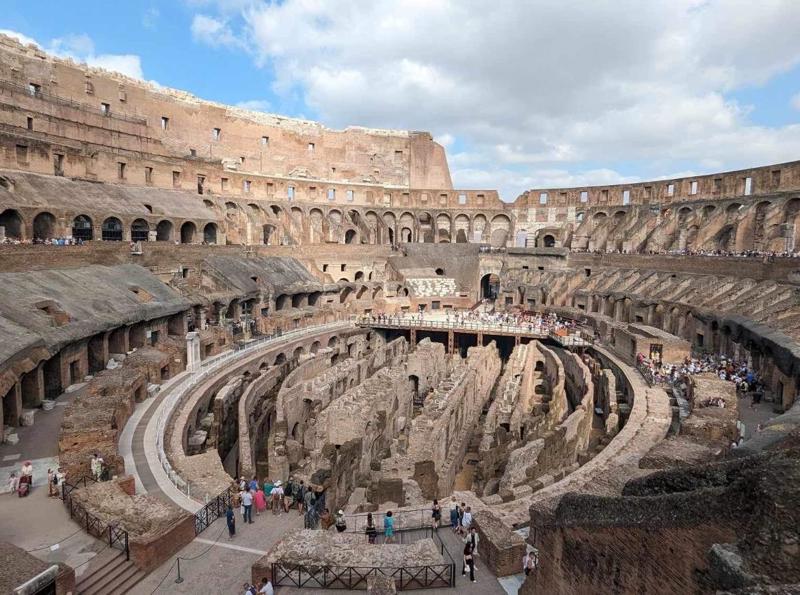
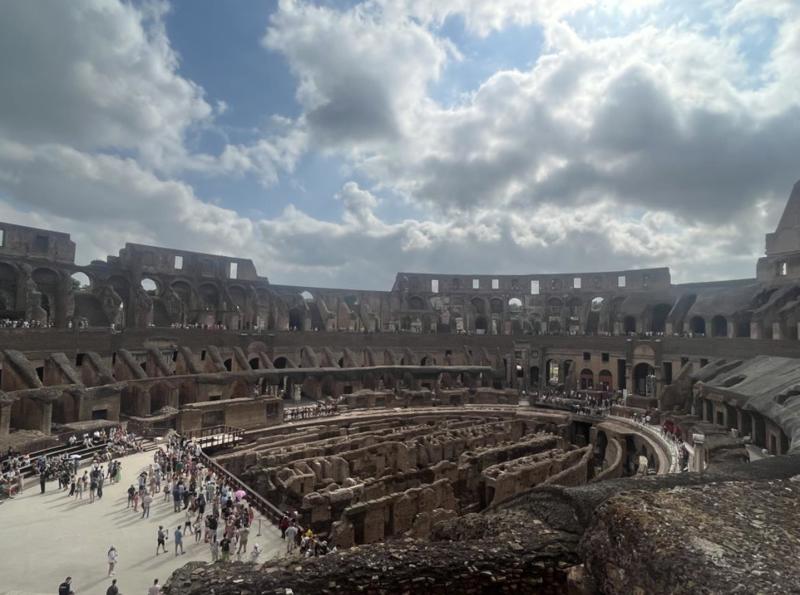
After leaving the colosseum, we walked to Trevi Fountain where we threw in a coin to “guarantee” our return to Rome. Then, we walked home via the Spanish steps. After a quick dinner, we fell into bed exhausted from all we’d seen.
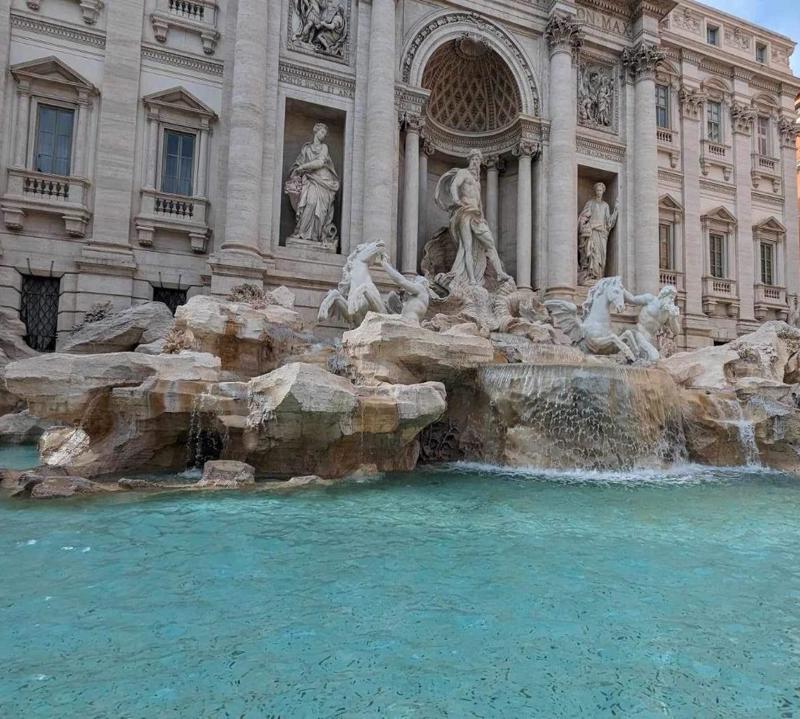
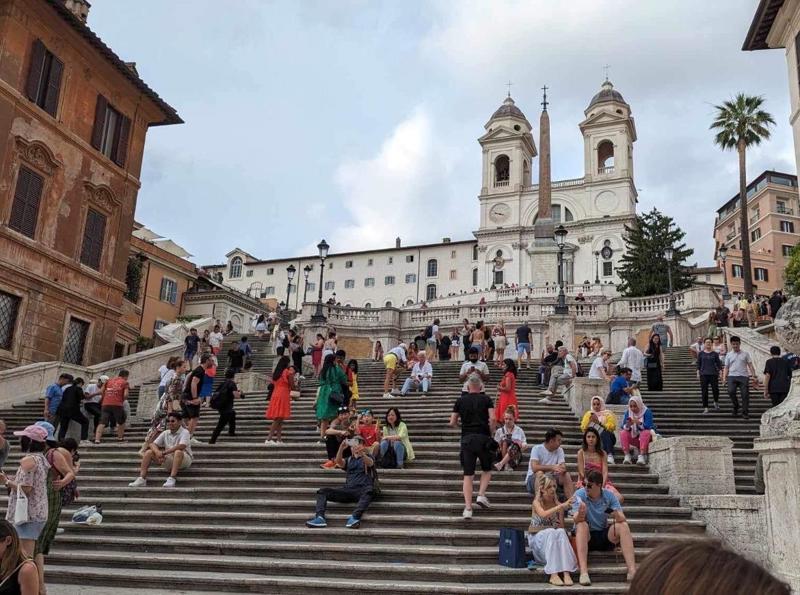
While Friday was focused on Ancient Rome, Saturday was the day for Christian Rome - and the Vatican state. After a morning on our own, we met up with the group to take the metro to St. Peter’s Basilica.
The largest church in the world, St. Peter’s Basilica is considered by many to be the most important building in Christendom. A focal point of millions of pilgrims each year, the Basilica is also a cultural, historical, and architectural landmark.
St. Peter's is also famous for its liturgical functions. The pope presides at a number of liturgies throughout the year both within the basilica or the adjoining St. Peter's Square
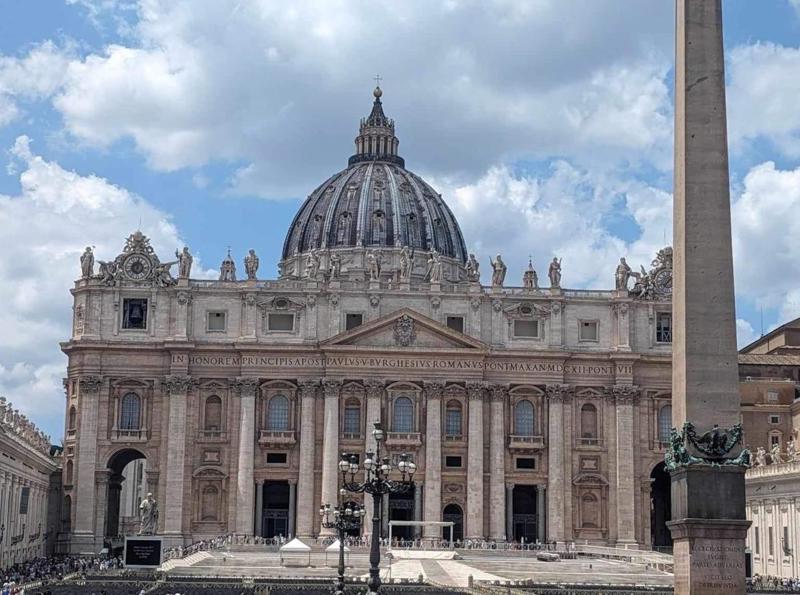
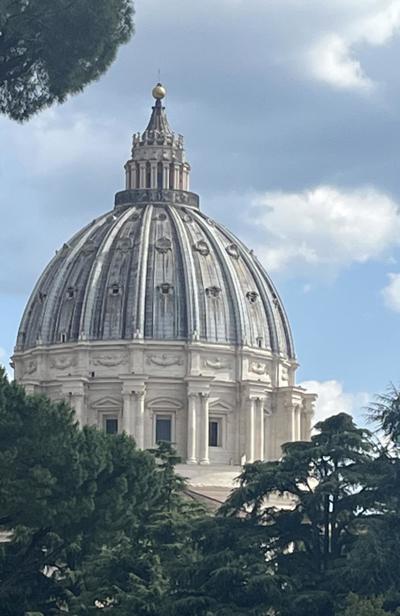
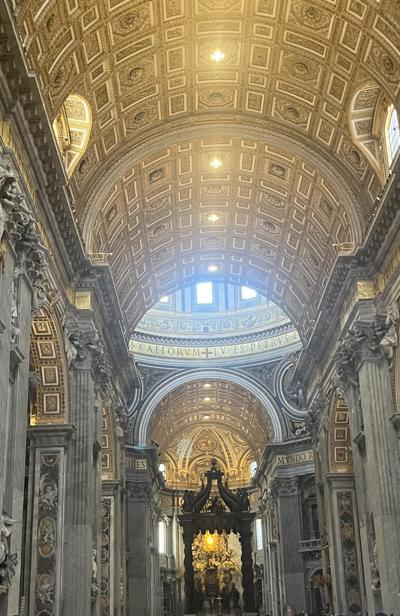
Catholic tradition holds that the basilica is the burial site of Saint Peter, chief among Jesus's apostles and also the first Bishop of Rome (Pope). Saint Peter's tomb is supposedly directly below the high altar of the basilica.
Putting the religious aspect aside, the art within the basilica is outstanding. Near the entrance, Michelangelo's Pietà is adored by pilgrims and tourists alike. Sculpted by the 25-year-old Michelangelo, it is a piece of genius in art and evokes strong emotions, regardless of one’s beliefs.

The high altar, like so much of the art decorating the Vatican, is a masterpiece by the great Baroque artist Bernini. Directly above the altar which marks the tomb of St. Peter, stands Bernini's bronze canopy, and above that Michelangelo's dome — taller than a football field on end. The inscription declares, in Latin: Tu es Petrus… "You are Peter and upon this rock I will build my church." This is the scriptural basis for the primacy of Rome in the Catholic Church.
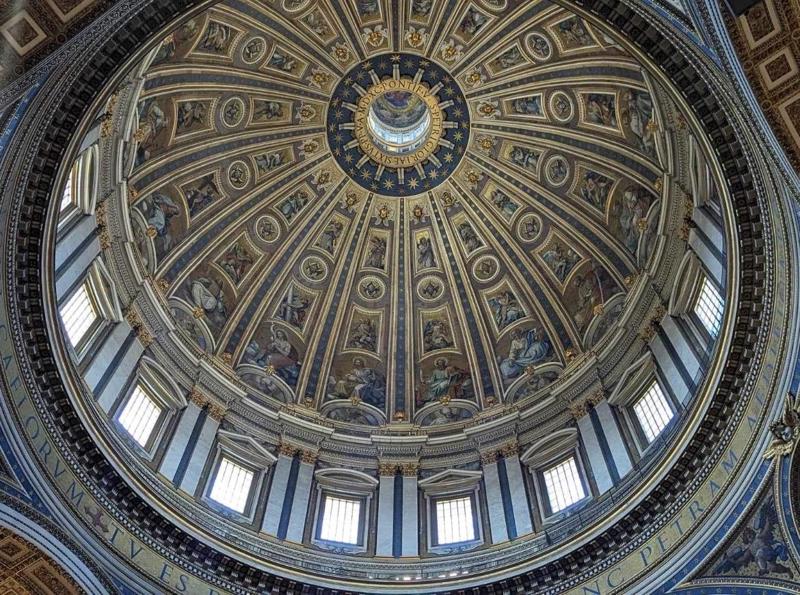
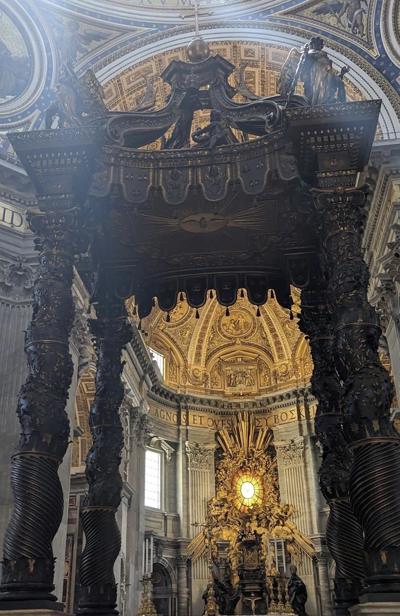
After leaving St Peter’s - and a gelato stop - we reached the Vatican museum. We walked through it very quickly, with a goal of reaching the Sistine Chapel.
The Sistine Chapel is decorated with splendid frescoes by Michelangelo. It was a sight to behold. Even with throngs of tourists, it was wonderful to see his creation. We weren’t allowed to take pictures, but Peter managed to snap this one for me.
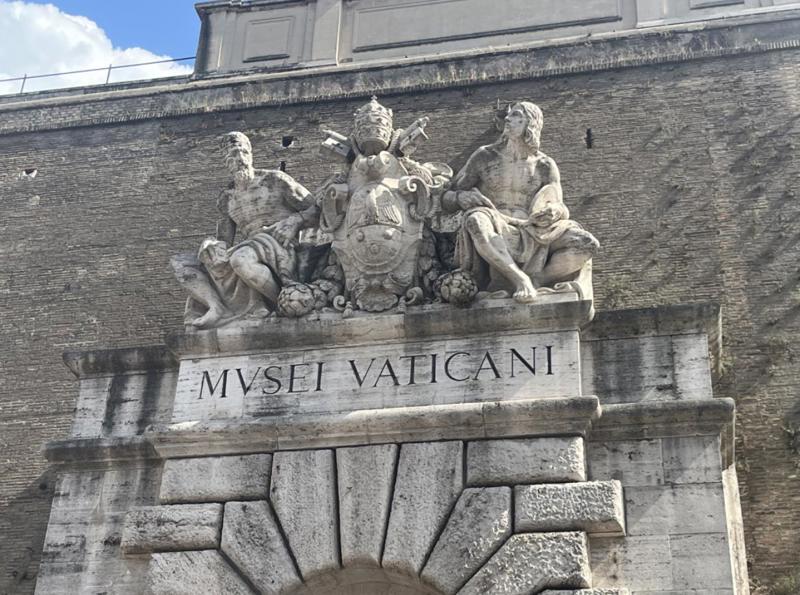
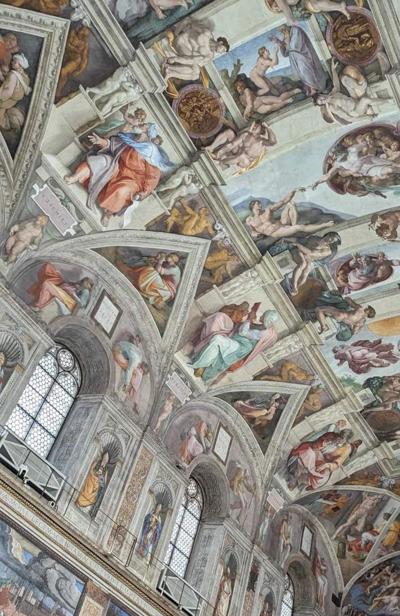
After returning to the hotel via the metro, we had a last dinner together as a group and said our goodbyes.
It was a great group of people and our guide, Daniel was stellar. She was informative, chose great places for us to visit when she had flexibility to do so, and kept the group engaged throughout.
She challenged us to push our limits and try new things and new foods. I ate cuttlefish ink and octopus!
I’m glad we did the RS tour. We got to see so much of Italy. I look forward to returning to some of our favorite spots in the future.
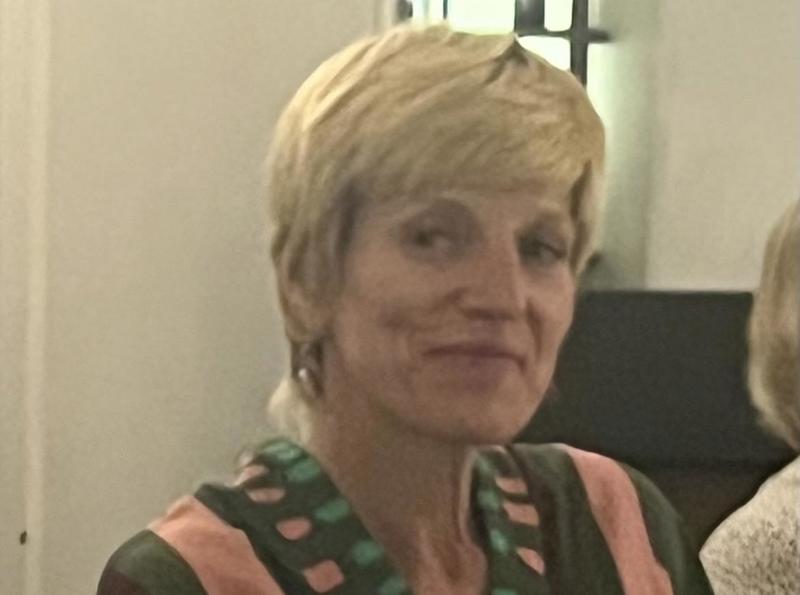
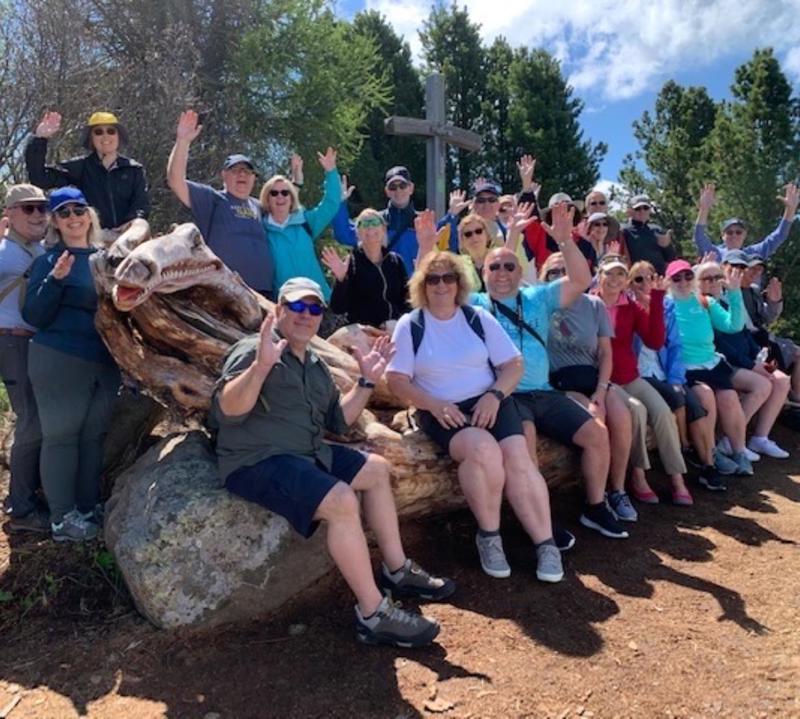
1.
Before we board
2.
And we’re off!!!
3.
The UK ports - Plymouth & Dover
4.
The Netherlands - Rotterdam & Delft
5.
Scandinavia: Oslo
6.
Scandinavia: Copenhagen
7.
The Netherlands - Amsterdam
8.
Paris - Parks & neighborhoods
9.
Paris - Museums
10.
Paris - Normandie D-Day beaches
11.
Paris - Giverny
12.
Paris - Chateau de Versailles
13.
Greek Islands cruise - Greece, Turkey & Italy
14.
Italy - Varenna
15.
Italy - Rick Steves Best of Italy tour
16.
The finale - Iceland
Share your travel adventures like this!
Create your own travel blog in one step
Share with friends and family to follow your journey
Easy set up, no technical knowledge needed and unlimited storage!